




As major democracies conduct elections in 2024, Facebook has come under scrutiny once again. In April 2024, a European research organisation called AI Forensics published a report about a covert influence operation named "Doppelganger." This operation involved Facebook ads containing proRussian messages that targeted voters. What is causing these issues with the social networking site? Global Business Outlook provides a detailed report on the online misinformation campaign.
Shifting our focus to the upcoming election in the United States, the job market data for May 2024 shows that employers in the world's largest economy added 272,000 jobs, surpassing economists' expectations. This increase from the 232,000 job average in 2023 has shifted the perception of an economy moving towards a more stable pace. Our article simplifies and explains what lies ahead for the United States.
The Global Automotive Industry Market Size was valued at $3,564.67 billion in 2023 and is expected to reach $6,861.45 billion by 2033, at a Compound Annual Growth Rate (CAGR) of 6.77%. The latest figures indicate that the industry is thriving after experiencing a slowdown due to COVID-19.
The cover story for the July-September 2024 edition will discuss the United Kingdom. The country recently elected its first Labour Party-led government in 14 years. The European nation has been grappling with issues such as high inflation, stagnant GDP growth, and a challenging costof-living crisis. In response, the UK has chosen to entrust Keir Starmer to lead the country in a comeback. The new administration faces the important task of addressing the fundamentals of the economy, ensuring competitiveness, and maintaining a business-friendly environment. It remains to be seen whether they can accomplish this.
Thomas Kranjec Editor kimberly@gbomag.com
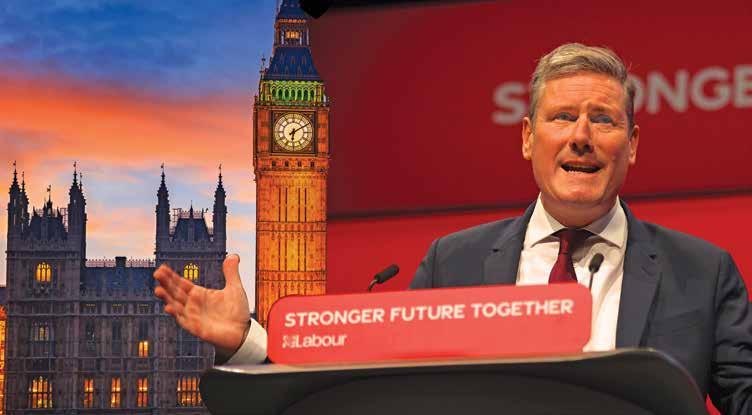




Editors

Director & Publisher
Krushikesh Raju
Editor
Thomas Kranjec
Production & Design
Brian Williams
David Brenton
Ian Hutchinson
Shankara Prasad
Editorial
Stanley Rogers, Rachel Taylor, Lucas Cooper, Alice Parker, Tom Hardy
Business Analysts
Priscilla Dorothea Salt, Adam Fagoo, Arthur Salt, Aamir Hussain, Sumith Jain
Business Development Manager
Benjamin Clive
Head of Operations
David Pereira
Marketing
Danish Ali
Research Analysts
Richard Sam, Sophia Keller
Accounts Manager
Edyth Taylor
Press & Media Contact
Craig Penn
Registered Office: Global Business Outlook Magazine is the trading name of
Business Outlook Media Ltd
Winston House, 2 Dollis Park, London, England, N3 1HF
Phone: +44 (0) 207 193 3740
Fax: +44 (0) 203 725 9247
Email: media@gbomag.com
Analysis
GBO Correspondent
The state of the labour market leading up to the fall will have significant ramifications for the upcoming election
Is the world’s largest economy showing signs of resilience? The answer may be yes, as the May 2024 job market data suggest that employers in the United States added 272,000 jobs, far surpassing economists' expectations of “Slowed Hiring.” This increase from the 232,000-job average over 2023 has shifted the perception of an economy moving towards a more stable pace.
Of particular concern for the Federal Reserve, which will meet in June and again in July, is the 4.1% rise in wages compared to a year ago. This could indicate that inflation is still a lingering threat.
However, Fed officials said that the recent inflation reports (along with other key data) showed a slowdown in price pressures, something the central bank had been eager to see for a long time.
Chicago Federal Reserve President Austan Goolsbee said the Federal Reserve has made “a lot of progress” in bringing the inflation rate down over the past 18 months, citing the recent Consumer Price Index (CPI) data a more positive one.
“It’s just one month, but it was very good. If we got a lot of months like this, we would be feeling so much better that we’re getting inflation to the Fed’s target rate of 2%,” Goolsbee noted.
Cleveland Fed President Loretta Mester, due to retire at the end of June 2024, termed the CPI report as a “great gift” for her last meeting, while also noting that inflation was still too high and would take “some time” until it reached its target rate, likely not until 2026.
Talking about the CPI data, it remained unchanged from April to May, apart from becoming the lowest monthly inflation rate since July 2022. The ratio has been down from a 0.3% monthly increase in April, and less than the 0.1% forecasters had expected. Over the past 12 months, prices rose 3.3%, down from 3.5% in April and less than the 3.4%

median forecast.
Analysts see slower price increases bringing relief to household budgets in more ways than one by stabilising the post-pandemic surge of inflation. Falling gas prices contributed to the lowering of inflation, falling 0.4% over the month, but are still up 3.6% in the 12 months ending May. Other forces were downward vehicle insurance costs and flattened grocery prices. Add low vehicle buying prices, along with reduced apparel and flight ticket costs, to the mix.
As per Beth Ann Bovino, chief US economist for US Bank, “For those who may have thought they would see a July rate cut, that door has largely been shut.”
While wage gains benefit workers, she pointed out that continued price increases diminish their purchasing power.
However, the outlook for the labour market is not entirely clear. According to the report, the unemployment rate
increased to 4%, its highest point since January 2022. This data, based on a survey of households, revealed minimal employment growth over the past year and an increase in part-time positions at the expense of full-time jobs.
While the data from employers, which determines job growth, is typically more reliable, the household survey has recently aligned more closely with other economic indicators. Retail sales have stagnated, the GDP growth rate has declined in the first quarter, and the number of job openings is at its lowest since 2021.
This is the reason why the majority of economists have anticipated a decline in employment growth and a further increase in the unemployment rate in the present year.
"Other than health care, we’re not seeing as much strength in the data. Growth in 2024 is unlikely to be very strong, consumers are pulling back quite a bit, and we expect that disposable income is also going to be affected," Parul Jain, Chief Investment Strategist with MacroFin Analytics said.


Healthcare has been a major driver of employment growth for the past two and a half years, accounting for 18.6% of the jobs added. The demand for healthcare services has been spurred by an ageing population and increased insurance coverage under the Affordable Care Act, increasing access to care for more people.
In contrast, the leisure and hospitality sector took until April 2024 to recover its pre-pandemic employment levels. Forecasts suggest that a record summer travel season may help boost employment in this sector in the months ahead, but most experts do not expect job growth to match the levels seen in previous years. Recently, United Airlines revealed that it plans to increase its workforce by 10,000 employees in the current year. This number is lower than the 16,000 jobs added in 2023 and 15,000 in the previous
year, signalling a shift from pandemic recovery to natural expansion.
Job growth exceeded expectations partly due to government employment rebounding faster than anticipated, despite predictions of a decline once federal pandemic relief funds were depleted. In May, the sector gained 43,000 jobs. However, there are still concerns about a potential slowdown in the future.
The labour market has seen significant growth thanks to an increase in legal immigration as well as a rise in the number of migrants with temporary status finding work through accelerated work permits. However, hiring for native-born workers has decreased while it has remained stable for those born outside the country, according to the WE Upjohn Institute for Employment Research.
President Joe Biden's executive order limiting asylum seekers at the southern border may impact this trend in the future. On a positive note, the percentage of people aged 25 to 54 who are actively working or seeking employment has reached its highest level since early 2002 at 83.6%, with women in this age group leading the way and achieving their highest participation rate on record in May.
The situation is less optimistic for young adults in their early 20s, as their participation rate decreased in May. With employers retaining their current workforce and fewer employees leaving voluntarily, there are limited opportunities for those with limited work experience, who have been struggling to find employment.
Additionally, individuals over the age of 55 have not re-entered the workforce in significant numbers, with their participation rate still two percentage points lower than before the pandemic. Some people have been forced back into work due to increased costs and insufficient retirement funds.
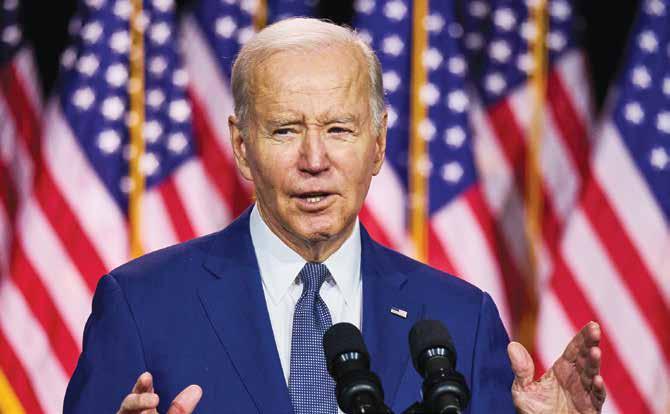
Biden emphasised the job creation aspect of the report, stating that under his administration, 15.6 million more Americans have gained employment. He also acknowledged concerns about inflation and highlighted efforts to lower prices.
The state of the labour market leading up to the fall will have significant ramifications for the upcoming election. While most experts predict a slowdown in growth, the chances of a recession are currently low unless there is an unexpected external event such as increased conflict or a financial crisis.
Reacting to the latest job market data, Biden commented, “Three years ago, I inherited an economy on the brink. With today’s report of 303,000 new jobs in March, we have passed the milestone of 15 million jobs created since I took office. That’s 15 million more people who have the dignity and respect that comes with a paycheck."
With the all-important Presidential election around the corner, the employment
stats will further boost the prospects of the Democrat's re-election bid. However, the bigger question here will be: What will be the Federal Reserve's next move? Will the interest rate come down?
The Fed has boosted the rate from almost zero to over 5% within the past sixteen months. As per its chair Jerome Powell, the central bank will only lower interest rates in reaction to what it believes to be a weakening labour market. The overall inflation is way less than the June 2022 peak of over 9%, but the Fed is still in wait-and-watch mode.
Minneapolis Federal Reserve President Neel Kashkari stated that it is a "reasonable prediction" that the central bank will reduce interest rates in 2024, with a probable December timeline. Will this prediction come to pass? We will have to wait and see.
Biden emphasised the job creation aspect of the report, stating that under his administration, 15.6 million more Americans have gained employment. He also acknowledged concerns about inflation and highlighted efforts to lower prices

Feature
As Richard Marsden looks across the Wear Gorge (a deep, narrow valley with very steep sides), there are more cranes in Sunderland's (in the United Kingdom) centre than he has ever seen. His design-build company, BDN, is working quickly to rehabilitate an ancient stable block that is located behind the football stadium in the city.
“Now there’s a bit of a resurgence, I want to be part of that,” Richard Marsden says of Sunderland, as joiners and carpenters fit out bars and a microbrewery ready for the new season, the Guardian reported.
The 140-year-old structure was originally the stables for the horses that were used to transport coal from the mines directly below Sunderland's Stadium of Light to the railway. Though they were on the other side of the deep river gorge, the stables were only a few hundred metres from Sunderland's city centre and stood abandoned, roofless, and neglected for many years. Marsden hopes those times are behind him.
This is not an isolated bet. The gorge-top skyline of Sunderland is rapidly changing as the city's leaders attempt to undo decades of urban centre hollowing out. This is an experiment in both local government intervention and an industrial strategy aimed at revitalising the flagging economy by focusing on eye-catching factories, the United Kingdom's dominant services sector, and cities.

Of the 905,000 cars produced in the British mainland in 2023, three-quarters were made in Sunderland
Source: Statista
Source: Statista

Government officials in Sunderland are hoping that other regions of the nation can take note of their intervention. Keir Starmer, who is expected to head a Labour government tasked with formulating its industrial and economic policies, may also be keeping a close eye on it if it proves successful.
Given that the party has retracted its plans for green investments earlier 2024, some Labour activists have expressed frustration over what they see as a lack of differences with the Tories. Notwithstanding, there is still a clear choice between the parties in this election, with the Conservatives led by Rishi Sunak dropping all mention of industrial strategy and abandoning their "levelling up" plan to correct regional disparities.
The Nissan model
Already, Sunderland is a shining example of one kind of industrial strategy. Margaret Thatcher was instrumental in convincing the Japanese automakers to establish factories in the UK at the beginning of the 1980s. Nissan selected Sunderland for its plant, bringing with it thousands of jobs that assisted in bridging the employment
gap created by the collapse of coal and shipbuilding.
Today, Nissan's factory is regarded as possibly the best example of British industrial strategy; it helped to establish an automotive supply chain in the northeast and convinced rival Japanese automakers Toyota and Honda to follow it to the United Kingdom.
The Conservative government has followed a similar course under each of its four prime ministers since Brexit, despite Sunak's seeming distaste for the concept of industrial strategy. Nissan has been convinced to upgrade its factory to produce electric cars by the generous subsidies it has provided. Workers in the factory express their pride, mixed with a hint of relief, at the plant's involvement in the revolution of electric vehicles.
Nissan is spending hundreds of millions of pounds to make the plant more productive. It will install upgraded car carriers that can support the additional weight of a battery while workers slot in, as well as robot arms that paint cars in an elegant pattern. By far the busiest production line in the United Kingdom, the automated lines are always in motion. Of the 905,000 cars produced in the British mainland in 2023, three-quarters were made in Sunderland.
In addition, the Chinese-Japanese joint venture Envision AESC is constructing two enormous "gigafactories" adjacent to each other in order to supply the automotive sector.
According to Paul Swinney, director of policy and research at the think tank Centre for Cities, Nissan's introduction to the outskirts of the city in the 1980s was a "good thing because the city was in a pretty bad place when they came in."
One example of how one inward investment can lead to more is the concentration of Japanese businesses in the surrounding area. But according to Swinney, who is also from Sunderland, luring in a single large corporation is

insufficient to keep a city viable. London is home to the Centre for Cities.
In 2016, it became evident that Sunderland was unhappy with its economic situation. Nissan was worried about how Brexit would affect business, which turned Sunderland into a symbol of the tensions that drove the referendum. The world saw pictures of a Vote Leave supporter with her arms raised and borne aloft on referendum night, which verified that.
Labour's three MPs for Sunderland retained their seats in the 2019 wipeout, in contrast to other areas of the so-called red wall. In the 2016 referendum and again four and a half years prior, voters rejected the status quo, and Kim McGuinness of Labour is aware that her responsibility is to deliver for them. The North East Combined Authority, which connects Northumberland with Durham via Tyne and Wear, elected her as its first mayor recently.
Kim has been a strong supporter of devolution, which she feels has not gone far enough and that Westminster still struggles to give cities like Sunderland priority.
"It's about determining our own priorities," she says, citing her prompt action to place public authority over the
area's bus system and the extension of the Tyne and Wear metro to neighbouring Washington.
Despite Nissan's success, the neighbouring city has not fully benefited from the economic boom experienced by Sunderland and Washington. Many of the factory's 6,000 employees commute from outside the city, and some even travel long distances to work there.
According to a 2009 Centre for Cities report, Sunderland's decline in the second half of the 20th century was "particularly comprehensive" due to the city's reliance on coal mining, shipbuilding, and glass manufacturing. It was also impacted by Newcastle, a nearby city that attracted a lot of the expansion in financial and business services.
McGuinness draws attention to the issue of child poverty in particular, attributing it to government underfunding. Using the government's multiple deprivation indices, seven of Sunderland's city wards rank among the 1,000 poorest of all 32,800 wards in England.
People chose to relocate to newly developed greenfield areas outside of the historic centre because it was more convenient to build there compared to
Despite Nissan's success, the neighbouring city has not fully benefited from the economic boom experienced by Sunderland and Washington. Many of the factory's 6,000 employees commute from outside the city, and some even travel long distances to work there
The new plan for the city is a complete reversal.
To improve the appeal of the underutilised riverbank, 1,000 residences will be built next to office buildings and a park on a hillside
repurposing old industrial and residential areas within the town. The local council consequently established Doxford International, an out-of-town business park, which now serves as the site for call centres and administrative offices for companies such as Barclays and EE.
Although there is a sculpture on the premises that pays homage to the city's shipbuilding history, the overall appearance of the business park, with its vast parking lots and simple office buildings, lacks any distinguishing features that connect it to its specific location.
The new plan for the city is a complete reversal. To improve the appeal of the underutilised riverbank, 1,000 residences will be built next to office buildings and a park on a hillside.
The massive Vaux brewery stood in this exact location before it was demolished in

the late 1990s. Although supermarkets were thinking about purchasing it, the council ultimately chose to make it the centre of attention, constructing a new city hall there in 2022.
Chief executive Patrick Melia of the Sunderland City Council says the authority hopes to double both the population and employment in the city centre. There are currently only 1% of people living there. In addition to the small pots of levelling up funding from the central government when available, it has actively courted investments from the private sector.
"We knew we wanted a diversified economy, standing beside a model showing the new city centre as the council imagines it, pointing to the mix of proposed housing, offices and a new eye hospital. The council fought hard to keep Nissan, but we didn’t want to be all in automotive and advanced manufacturing," Melia said.
A former fire station has been renovated into a restaurant and theatre. Additionally, efforts are being made to connect the developments so that people can stroll from the high street to Keel Square, which is in the middle and is visible from Hays Travel's headquarters and from there to the new development.
The chief of the North East Chamber of Commerce, John McCabe, is pleased that the emphasis is being placed on luring in jobs in the services sector and that the factories on the outskirts of the city are receiving the most support.
"There’s got to be a place for both. It would be ill-advised to put all of your eggs in one basket. For probably too long we thought, as long as Nissan is there, that’ll be OK," McCabe said.
Since the Conservatives and Liberal Democrats first formed a coalition in 2010, local governments have faced financially difficult periods of austerity. Amidst fiscal strain, certain councils, particularly Woking in Surrey and Thurrock in Essex, were seduced into insolvency by commercial properties that professed
substantial profits, but ultimately served as incomplete symbols of the conceit of nearby politicians.
Melia thinks Sunderland will escape that fate. Firstly, in contrast to some of the calamitous council plans, the riverside plan has received £100 million in funding from Legal and General, a significant endorsement from the largest investment manager in the UK. It was highlighted as an example of the investor supporting the UK economy by an influential former boss of L&G, Nigel Wilson.
A recently constructed footbridge connects the Stadium of Light and the new offices in a direct line across the river. Despite struggling during its sevenyear absence from the top flight, which included a disastrous double relegation, Sunderland AFC boasts the ninth-largest football stadium in England. Fans, however, continue to arrive. In 2025, the bridge will land directly next to the Sheepfold Stables, bringing with it what Marsden anticipates will be a constant flow of spectators seeking a place to get a drink during game days. Additionally, though, he wants to draw visitors from outside Sunderland.
Leo Pearlman, the Sunderland-born cofounder of Fulwell 73, is the driving force behind Crown Works Studios, an ambitious plan to create 8,500 film and TV jobs in the northeast, which is another important component of the city's hopes located a mile up the Wear. That might lead to more economic diversification.
According to Pearlman, it might have a greater effect on Sunderland's economy than the gigafactories that are being developed close to the Nissan facility.
The £450 million project received planning approval in March from the council. FulwellCain, a joint venture between Fulwell 73 and London investment firm Cain International, is handling the development.
Pearlman wants the government to support the UK's services sector in the same way that it supports factories, even
though the latter greatly outpaces the former in all categories save hard-hat photo opportunities. Envision is building gigafactories nearby, and the project has received hundreds of millions of pounds in grants and loans.
"This is a factory – that’s exactly what it is. The impact that it will have is exponentially bigger than a gigafactory, for example," Pearlman says of Crown Works Studios.
Small company owners are beginning to notice a shift in the atmosphere. Ian Wright of New World Designs says his clients in sports and fashion advertising "cannot grasp how desperate it was" for the city once the industry left. Wright's company uses arrays of cameras to create "bullet time" videos reminiscent of the Matrix. Although his adopted city of Sunderland was "derelict" and "dead," he had come to study there in 1999. He thinks that discontent over local budget cuts and a lack of investment contributed to the Brexit vote.
Wright is reasonably upbeat about Sunderland's future and the potential media companies that could arise from the success of Crown Works Studios.
“It’s starting to look like a proper city. It’s the first time seeing that many cranes. You can almost see the tide turning. Yet it has got a long way to go," Ian Wright said.
Even though the factories are impressive, whether or not higher-paying jobs arrive will be the real measure of Sunderland's success. Nissan provides a noteworthy example once more.
Although there are plenty of wellpaying engineering and design jobs in London and Cranfield, Bedfordshire, the majority of manufacturing jobs are found in Sunderland.
“Would (a company) put its high-value stuff as well as its low-value stuff there? If the answer is no, then you haven’t levelled up," Swinney asked.
Leo Pearlman, the Sunderlandborn co-founder of Fulwell 73, is the driving force behind Crown Works Studios, an ambitious plan to create 8,500 film and TV jobs in the northeast, which is another important component of the city's hopes located a mile up the Wear. That might lead to more economic diversification
Keir Starmer

GBO Correspondent
The United Kingdom recently had its Parliament elections. It was a crucial affair, given the fact that the European country's unfortunate tryst with skyrocketing inflation, stalled GDP growth and an unbearable cost-of-living crisis crippled British society by leaps and bounds.
From 2019 to 2022, the Conservative Party had to change its Prime Minister twice: first by replacing Boris Johnson with Liz Truss and then by substituting her again with Rishi Sunak. Talking about Truss' 50-day reign between September-October 2022, her disastrous "Mini Budget" earned infamy by proposing significant tax cuts, apart from abolishing the 45% rate of income tax and the proposed Health and Social Care Levy, cutting stamp duty and the basic rate of income tax and cancelling rises in National Insurance contributions and corporation tax.
The government became massively unpopular and when the polling day arrived, the huge anti-incumbency unseated the 15-year Conservative rule. Keir Starmer, leader of the centre-left Labour, took over as the country’s next Prime Minister, with Rachel Reeves becoming the first-ever woman Chancellor of the Exchequer.
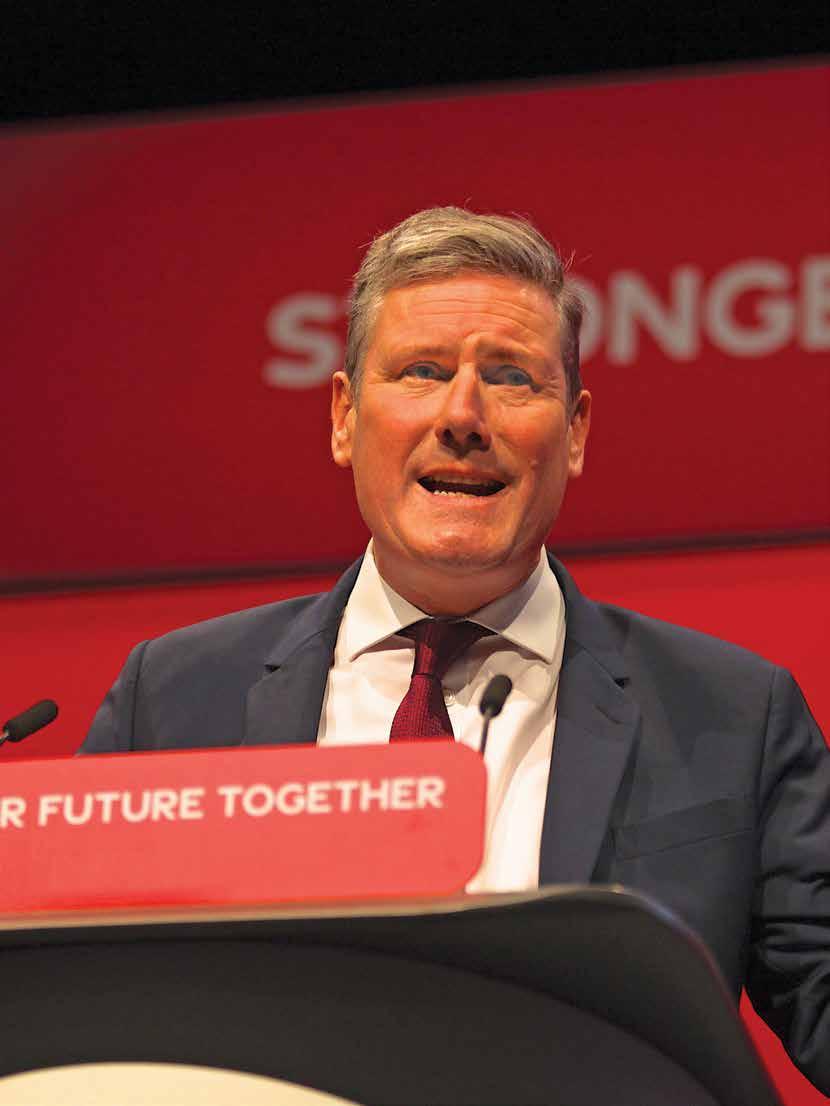
As stated in Labour’s manifesto, the Starmer government wants 1.5 million homes built in England in five years
Keir Starmer
In good news for the new British government, the UK economy grew by 0.4% in May 2024, after exiting a shallow recession in the first quarter of the year. The nation’s dominant services sector continues to grow further, as output in both production and construction rebounded from losses.
Price rises in the UK have cooled from a 41-year high of 11.1% in October 2022, all the way down to the Bank of England’s 2% target in May 2024. The performance has raised expectations for a coming interest rate cut from the Bank of England (BOE).
However, the BOE continued to strike a cautious tone at its June meeting even after its peers at the European Central Bank (ECB) began their own path of interest rate cuts, warning that key indicators of inflation persistence in the UK “remained elevated.” Markets remain roughly evenly split on the prospect of a cut at its August 2024 meeting.
Even though there has been a broad-based increase in economic output, no way we can conclude that the UK is completely out of the woods. Labour has set itself the aim of achieving the fastest growth among the Group of Seven (G7) advanced economies on a sustained basis. The longer-run picture remains weak, with the economy only 2.7% larger than its pre-pandemic level of late 2019.
Over the three months to May 2024, the economy expanded by 0.9%, the strongest reading since the three months to January 2022, compared with the consensus forecast for a 0.7% expansion. The BoE expected the economy to grow by 0.5% over the 2024 Q2, something as per the analysts, looks likely to prove too low.
Britain's overall trade deficit, excluding precious metals, narrowed to 3.2 billion pounds ($4.1 billion) in May from 4.7 billion pounds in April. However, goods exports to the European Union fell to their lowest since January 2022, when Brexit customs checks were introduced, and consistent with levels seen during the late 1990s. Keir Starmer wants to reduce trade frictions with the EU but he will not agree to join the bloc's single market.
Since the COVID-19 pandemic, Britain's economy has been the second-weakest among the G7 countries after Germany, adding to the drag on incomes that, adjusted for inflation, have struggled to gain since the 2007-2009 financial crises. Slow growth may also limit the Labour government's ability to offer
quick progress on fixing the country's strained health system and other public services, given Starmer's promise to voters not to raise the main forms of taxation.
Keir Starmer wants to get Britain back to its 2.5% growth pace of the early 2000s with a combination of reforms to the restrictive planning system that has thwarted home-building and new infrastructure, support for strategic sectors and providing the political stability needed for attracting investors. However, his government is at the mercy of the shortterm outlook for the economy as of now and the short-term results look promising. That immediate outlook appears to be brightening.
The government's hopes of getting more room in the budget to invest in Britain's struggling health service or fix the many other problems in the public sector lie with the longer-term forecasts of the country's budget watchdog, the Office for Budget Responsibility, which will publish its next assessment of the European country's growth prospects when Rachel Reeves delivers her first budget statement, somewhere in October or November.
The Starmer-Reves duo may need to focus further on reducing service sector inflation. The IMF’s economic counsellor, Pierre-Olivier Gourinchas, told the Guardian that the UK's situation was similar to the United States in having “somewhat persistent services inflation." His comments matched the tune of the Bank of England policymakers about the risks of service sector inflation becoming embedded. Since 2024 beginning, the headline rate of UK inflation has halved to 2% while service sector inflation has fallen from 6.5% to 5.7%.
Polling data suggests frustration with the state of the economy indeed emerged as a major reason behind the Conservatives' defeat. According to the Pew Research Centre, just 22% of potential voters thought that the British economy was in good shape. Talking about the Conservative Party supporters, in 2017, around 75% of them were positive about the economy. That figure, in the lead-up to the polling day, went down to as low as 27%.
The UK economy came out of recession in the first quarter of 2024, with a better-than-expected growth of 0.7%. Inflation started falling to the Bank

Keir Starmer
Keir Starmer has inherited a British economy that has somehow escaped recession. He also needs to rebuild the British healthcare apparatus that was stressed by the COVID-19 pandemic
of England’s target of 2% for the first time in three years. While both Conservative and Labour argued over various issues in the lead-up to the elections, their focus points on the economy were more or less the same, be it boosting productivity and GDP growth. However, what Liz Truss' disastrous 49-day reign did was bring to the table highly unorthodox economic policies, lacking both logic and vision. That wrecked the Conservatives’ selfimage as a party known for economic competence.
Rachel Reeves holds broadly similar positions to Hunt on taxation and the government’s fiscal rules, which will be crucial when it comes to public spending policy.
However, Creon Butler from the British think tank Chatham House believes a fundamental economic shift may be coming, while mentioning that the Labour Party differs fundamentally from the Conservative Party in three areas of economic policy: the role of the public sector, regulation, and attitude to the European Union.
Butler says Labour have less “baggage” than the Conservatives with regards to the EU, and that while they don’t necessarily want to reopen negotiations around, for example, re-joining the Customs Union, they will be keen to develop more cordial and productive EUUK relations than have been the case for the past few years.
A major issue for the Starmer government will be public investment.
A recent study from the Institute for Fiscal Studies, a United Kingdom-based economic research institute, predicts that public sector investment, as a percentage of GDP, will decline from an estimated 2.4% of GDP in 2024 to as low as 1.8% of GDP by 2028.
Keir Starmer has inherited a British economy that has somehow escaped recession. He also needs to rebuild the British healthcare apparatus that was
stressed by the COVID-19 pandemic. He has ruled out any hikes in income tax, national insurance welfare contributions, and value-added tax (VAT). However, as per the AFP, senior Labour leaders have not ruled out hiking other taxes which would be rather limited in scope but needed to boost public spending.
Once famed the world over, the British National Health Service (NHS) has been struggling big time amid strikes, budget crunch, and personnel shortages. The condition is such that the waiting list of patients is more than 7 million. The Labour Party has promised it would pay the staff extra to work in the evenings and on weekends and would use the spare capacity in private healthcare facilities to deliver two million more NHS appointments a year to clear the backlog.
Keir Starmer has also proposed a “Great British Energy” plan with the dual objectives of insulating the UK from international energy shocks as seen from the Ukraine War in the past two years and meeting the UK’s climate targets. He has further set 2030 as the target for decarbonising the British electricity grid. The wind has emerged as a key engine of change for Labour, which believes it will help the UK economy grow. The new government has promised big steps: doubling onshore and quadrupling offshore turbines by 2030. By removing the ban on onshore wind in England just a few days into power, Labour wants to show this is a key priority.
Labour will rework the process of calculating the minimum wages by factoring in the cost of living. It will likely further make flexible working “the default” and ban “zero-hour contracts,” under which employers are not obliged to provide any minimum working hours and the worker is not obliged to accept any work offered. The government also wants to tackle the crisis of the rising levels of unemployment through the creation of

new national jobs and career services. It will be based in job centres but with local areas able to tailor the scheme depending on their own employment needs.
Rachel Reeves era begins
In her first speech as Chancellor of the Exchequer, Rachel Reeves vowed to "get Britain building again", to boost economic growth. At the core of her plans remain compulsory housebuilding targets, which were ditched by the Rishi Sunak regime, with Reeves further committing that her administration was willing to take an “interventionist approach” to achieve the targets.
As stated in Labour’s manifesto, the Starmer government wants 1.5 million homes built in England in five years. That’s a daily average of 822 homes, or roughly a new housing estate, every day. But a target is one thing, and delivering a
level of housebuilding not seen since the 1960s is another.
"The plans will rely significantly on private housebuilders. While they may have the capacity, the market conditions and commercial justification will have to suit them. Questions have already been raised about whether a sufficiently skilled workforce is available. And strap yourselves in for some battles at a local level when council planning committees face potentially stiff opposition from residents," explained BBC.
Analysts are expecting Reeves to unleash tens of billions of pounds of investment in green industry and housebuilding. As per her playbook, planning decisions for major infrastructure projects in Britain will be made nationally rather than locally in an attempt to stop important projects from becoming tied up in years of red tape.
As stated in Labour’s manifesto, the Starmer government wants 1.5 million homes built in England in five years. That’s a daily average of 822 homes, or roughly a new housing estate, every day
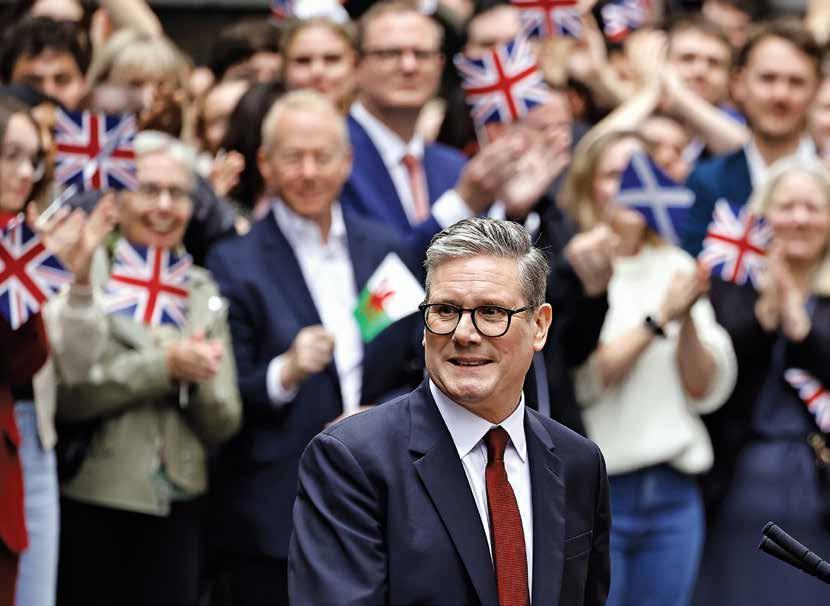
The Conservative government under Boris Johnson had set targets for housebuilding in 2019, but these were ditched when Rishi Sunak took over the reins. This time around, the StarmerReeves duo will need the private sector to deliver the Labour's homebuilding plans
The transport and energy secretaries will prioritise decisions on infrastructure projects that have been "sitting unresolved for far too long," while additional planning officers will be recruited to speed up the planning process. Talking about Labour's housing sector plans, the "right mix" of affordable housing and homes for social rent will be built.
Labour will also overturn rules brought in by the Tories in 2015 which effectively meant that a very small number of objections could block new onshore wind projects. The course correction will result in the hundreds of new turbines being built in quick times, giving the country a much-needed alternative source of 24/7 power supply (and in the long run, cutting down its dependence on Russian gas).
While the proponents of compulsory housebuilding targets
say these plans are necessary to make sure councils build the number of houses required, opponents say the mandatory approach has been tried unsuccessfully for decades and it risks forcing development on greenfield sites (lands which have not been developed) against the wishes of locals.
The Conservative government under Boris Johnson had set targets for housebuilding in 2019, but these were ditched when Rishi Sunak took over the reins. This time around, the Starmer-Reeves duo will need the private sector to deliver the Labour's homebuilding plans.
Trade group the Home Builders Federation has called for more support for people to get on to the housing sector ladder, including the return of a government support scheme for first-time buyers. In short, government support is required (in

the form of subsidies) to ensure that people are in the position to splurge money and buy their first homes, propelling up the demand in the process.
David Barnes, head of policy and public affairs at the Chartered Institute of Building, while interacting with the BBC, also said that the Starmer administration needs to be realistic about the significant lack of skilled workers the construction industry is currently facing.
Will Reeves be the gamechanger?
In the words of BBC's economic editor Faisal Islam, Reeves believes in the philosophy of "opening up the chess board for later in the game, as the moves become particularly good when one wants to go on the attack."
She will be now applying the mathematics of constantly changing
trade-offs to running the British economy.
"As she told me at her general election count, four hours after the exit poll had dropped, there’s not a huge amount of money there and therefore she was willing to have a fight on ripping up red tape holding back the private sector from building new homes and rebuilding Britain’s infrastructure," Islam remarked.
Immediately after Reeves' election victory, Treasury officials worked through the weekend to put together Labour’s planning shake-up as part of a big bang announcement to communicate directly to business leaders. It was designed to show total commitment to the growth agenda. Two green-belt data centres that had been blocked by local councils were given planning permission. Two house-building projects were unlocked as well.
Reeves wants the Treasury to go above its tax and spend duties and become the “growth department," with the peer Spencer Livermore, now effectively her deputy for growth, alongside the Chief Secretary Darren Jones, who will focus on tax. The plan is to project the country as an area of optimism for investors.
More than accepting the difficult situation of borrowing, tax and spending, Reeves wants her office to “improve the trade-offs” too. The more confident investors get about Labour’s plans, the more money will pour in, and the more tangible improvements in the economy will be.
She will publish details on the state of the public finances, which will help set early parameters for big tax and spending numbers in the autumn. She will be tough on adhering to rules designed to limit borrowing for daily spending. She may need to potentially
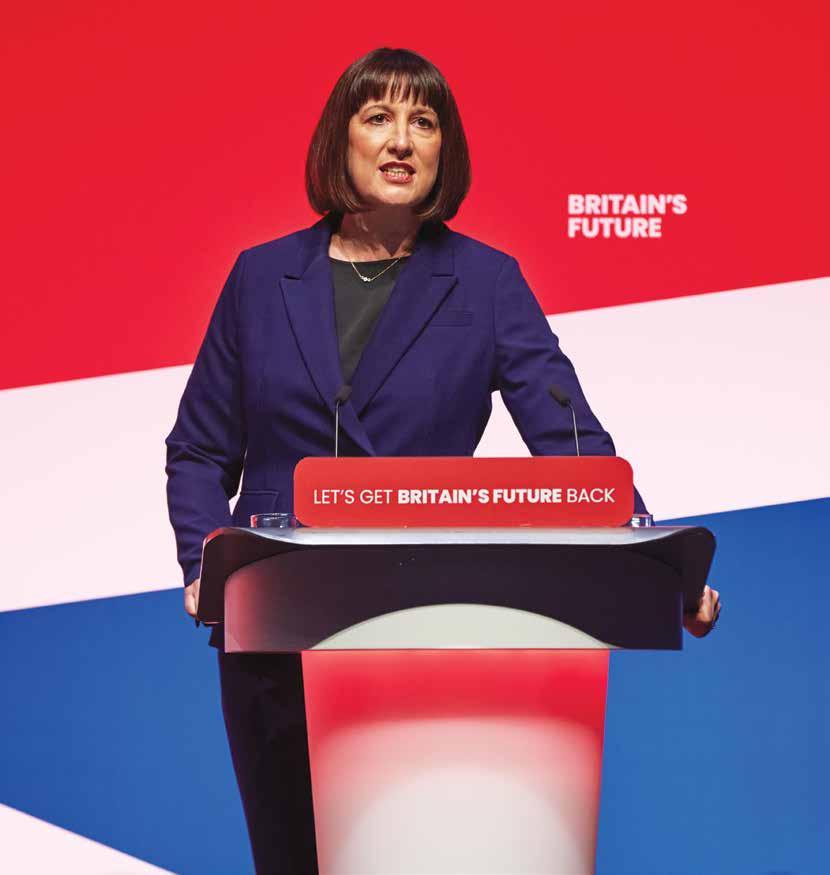
Targets of social development in the Kingdom of Saudi Arabia according to the Vision 2030 in 2016 and in 2030 (In Percentage)
Source: Statista
cut spending on councils, prisons and courts and raise some taxes to do this.
When asked about delivering policy changes to housebuilding, infrastructure and energy investment, while the Starmer government continues cuts to public investment planned by the Conservatives, Reeves told the media, “We need the private sector to build homes; we are not going to be in the business of constructing homes ourselves.”
She will bring her chess skills to the play by fixing the foundations first, then rebuilding Britain, and then making every part of the country better off. Given the thunderous nature of the Labour's victory (411 seats out of 650), Reeves has the much-needed stability to play a rather long game.
Reeves has pulled off another potential masterstroke by launching a £7.3 billion National Wealth Fund (NWF), to attract billions of pounds of private sector cash for big infrastructure projects across the United Kingdom. The NWF will help projects such as ports, gigafactories, hydrogen and steel projects to attract a mix of investment, aiming for roughly £3 of private funds for every £1 of taxpayer cash.
Reeves said the fund would essentially operate as a “concierge service for investors and businesses
that want to invest in Britain, so they know where to go."
The investments will then be managed by the existing UK Infrastructure Bank, headed by the former HSBC chief executive John Flint, with support from a revamped British Business Bank, best known for running the COVID-19 business loan schemes. Reeves has also formed a taskforce, spearheaded by the noted senior officials from banking giants like Aviva, NatWest and Barclays, along with the former Bank of England governor Mark Carney.
Labour has also proposed GB Energy, another publicly owned company that will focus on the “production of clean, low carbon energy”. The investment made via the NWF will seek to deploy £1.8 billion to ports, £1.5 billion for gigafactories including the ones for electric vehicles, £2.5 billion to clean steel, £1 billion for carbon capture and £500 million to green hydrogen.
Jonathan Reynolds, the business and trade secretary, during his meeting with more than 170 senior leaders from businesses and trade associations around the UK, set out his key priorities: delivering an industrial strategy, which will be the cornerstone of the Labour government’s growth mission; supporting small businesses,
described as the “beating heart” of high streets, communities and economy; resetting trade relations and championing British exports; and making work pay.
Reynolds told business leaders that he was aware that a key challenge for businesses is connectivity and the grid, and promised a crossgovernment focus on tackling this. He also promised to be “the most accessible” business secretary.
The new government is showing signs of making the British economy grand and competitive once again, but the journey will be long and treacherous. The opening few days have been great, with the StarmerReeves duo setting out their priorities clear. However, they have inherited an economy whose growth ratio has been worse than below par. The Labour's massive victory margin has given it the breathing space to comfortably play the long game of fixing the basics. At the same point in time, the new government has sent the message among the investors that it will be a "Pro-Business" one.
Will the "Good Old British Economy" make a comeback soon? Only time will tell.
GBO Correspondent Analysis
According to recent studies, the top 1% of American businesses own 90% of the assets connected to American manufacturing and generate 80% of the country's sales income
There was a contentious discussion about the function of economic planning during the Cold War. Was resource allocation more efficient in the USSR's "planned" economy or the United States' "free market" economy?
The limitations of information processing, the viability of production forecasts, and the rigidity of centralised plans were the main points of contention against planned economies.
The idea of economic planning appeared to have been consigned to history with the fall of the Soviet Union. However, the topics discussed in those discussions are still pertinent today.
According to recent studies, the top 1% of American businesses own 90% of the assets connected to American manufacturing and generate 80% of the country's sales income. This indicates that a very small group of businesses account for the bulk of economic activity in the United States.
Planning, especially synchronising operations throughout international supply chains, is a major strategic priority for these businesses. Americans rarely consider the value of planning, even though it is essential to the economy as a whole and the supply of consumer goods in particular.
It is important to comprehend the planning implications.
A political system in which a central governing body sets the maximum allowable output levels and the maximum pricing for goods and services is known as a command economy. Governments own the majority of industries in command economies.

A free market economy, where supply and demand determine prices and production, is the primary alternative to a command economy. A free market system is present in capitalist nations, but the command economy is part of a communist political structure.
Three countries with command economies include the former Soviet Union, North Korea, and Cuba. Up until 1978, China had a command economy. After that, it started the process of converting to a mixed economy, which combines aspects of capitalism and communism. One description of its current structure is a socialist market economy or authoritarian capitalism.
The central government of a country must possess and manage the means of production in a command economy, sometimes referred to as a planned economy.
There is either no private land ownership at all or very little. Central planners determine prices, manage output and restrict or forbid competition in the private sphere. Because the central government owns or controls every enterprise, a pure command economy lacks a private sector.
Government authorities determine national economic priorities in a command economy, along with the best times and means of generating economic growth, allocating resources, and distributing the results. This usually takes the shape of a long-term plan.
Private businesses set their output levels in a freemarket economy in response to supply and demand. The government makes all the decisions in a command economy. The laissez-faire theory is rarely the only operating principle of a free-market economy. A government may promote the manufacturing of a product by enacting laws and regulations. Certain command economies have relaxed their regulations. China did not experience its economic boom until it developed a unique fusion of capitalism and socialist philosophy.
In a command economy, pricing, distribution, and allowable production levels are all determined by a single, central government body. It is a part of political systems that are communist. Free markets, where supply and demand play a major role in determining prices, are different from command economies.
The term "supply chain planning" describes a series of linked, iterative choices made to continuously maximise earnings by matching a company's capacity, inventory, and other assets. It incorporates a variety of choices made over a variety of time horizons, ranging from the near-term scheduling of supplies to the longer-term optimisation of global supply networks.
Based on changing consumer demand, planners also determine how much merchandise to manufacture or purchase. They also manage the time needed to ensure that goods reach the appropriate time, location, and form, possibly the most significant aspect of their work. They carry out millions of transactions every day involving thousands of products, not just one.
Think about an average Walmart shop, which at any given moment offers over 120,000 different stock-keeping units, or SKUs, or merchandise. Over 10,000 retailers across the globe, in addition to online and at residences, must carry these products 24 hours a day, seven days a week.
In most firms, these dysfunctions are widespread. However, the COVID-19 outbreak brought to light what many planners already knew: outdated supply chains, talent shortages, and outdated planning tools prevent businesses from meeting delivery deadlines.
Planners have been integrating their organisations' essential business operations, from raw material purchasing to point of sale, for decades using enterprise resource planning systems, a type of business-management software. Designed in the 1990s, these systems have many inherent problems and can be stiff. They are frequently based on models from the 1960s.
Additionally, businesses frequently use hundreds or even thousands of separate systems to manage databases and workflows. Because of this, planners have to piece together insufficient data from several sources to calculate dynamic supply-anddemand requirements.






Source: Statista

Every deodorant variant has a distinct SKU. It's also necessary to provide them in a variety that fluctuates frequently, sometimes significantly, according to customer tastes and external circumstances. Competitive pricing is necessary for products, which encourages a never-ending hunt for cheaper input prices. Planners endeavour to efficiently balance supply and demand by organising this enormous network of people, goods, and locations.
finest-laid schemes
Long wait times and empty shelves are the most evident indicators of planning dysfunction. Billions of dollars’ worth of extra inventory are less evident. Furthermore concealed are significant waste and delays in innovation across the supply chain.
Automation has great promise for resolving technical issues, particularly when it integrates learning algorithms. However, the data requirements are overwhelming.
For those of us who signed up for a setit-and-forget-it delivery service and now have an overstocked pantry of toothpaste, you understand the risks associated with automating decisions based on a forecast. It takes very high-quality data and complex analytics to solve that issue for a global supply chain. Most businesses haven't arrived yet.
Furthermore, it's unclear whether the personnel required to run the systems are prepared, even if they are available. Planners are being used more and more by businesses to oversee supply chain operations.
However, today's planning professionals require completely different knowledge, abilities, and attitudes. Planners need to be significantly more adept at leading change,

handling ambiguity, and adjusting to emerging technologies.
The supply chain is currently experiencing problems with training and personnel shortages, making talent planning imperative. Though there are now many creative educational initiatives, it will take time to cultivate the necessary skills.
Last but not least, the worldwide reach of today's supply networks presents ongoing planning issues. A corporation must still transport its inventory across international borders, even if it has the personnel and processes in place to optimise inventories for future demand.
Planners must therefore not only solve a challenging demand-supply matching problem but also carry it out using trucks, trains, aeroplanes, and ships. Take even a cursory look at the headlines to understand how hard that can be. Global warfare and infrastructure failure are among the risks.
Businesses are gradually expanding their regional networks and moving their supply chains to less hazardous locations.
However, it takes time to attract business partners and build new facilities. Since planners will make these choices, systems, and talent are also required.
Many of the concerns that resurfaced in the Cold War economic planning debates are also present in today's business challenges. There are distinct distinctions from centralised planning in the Soviet style. However, many businesses plan to control large portions of the American economy. Planning errors can quickly result in commercial failure for individual organisations. Additionally, planning dysfunctions create both excess and scarcity at the level of the economy. It implies having too much stuff but not the proper stuff people require to live better lives.
The supply chain is currently experiencing problems with training and personnel shortages, making talent planning imperative. Though there are now many creative educational initiatives, it will take time to cultivate the necessary skills

China's leaders are under more pressure to rekindle domestic growth given the prospect of increased trade barriers, especially if Donald Trump wins re-election as US President later this year

China's economy contracted more than anticipated in the latest quarter, raising the possibility that initiatives to spark growth will be revealed at a summit of senior officials in Beijing. The second-largest economy in the world grew by 4.7% between April and June 2024, as compared to 2023, according to data released by the National Bureau of Statistics.
The March quarter's growth rate of 5.3% and the 5.1% rate that economists had projected were both lower than this result. The real estate market kept declining; in the first half of 2024, sales of brand-new commercial buildings decreased by 25% overall.
China may find it challenging to reach its annual GDP growth target of roughly 5%, as evidenced by the fact that retail sales in June decreased by 0.12% from May. There was a record trade surplus of nearly $100 billion in June alone, which helped to offset the relatively poor quarterly result, due to the export of excess manufactured goods.
China's leaders are under more pressure to rekindle domestic growth given the prospect of increased trade barriers, especially if Donald Trump wins re-election as United States president later this year.
The data was released during a major political gathering in Beijing, where senior Chinese officials are known to have unveiled significant changes to the country's overall economic policies.
"Turning these (economic) trends around should be front and centre of this week’s third plenum," Harry Murphy Cruise, an economist with Moody’s investor services, said.
Nevertheless, he noted that "big policy pivots can be taken as an admission of failure and a sure-fire way to lose face" in China, so those hoping for significant economic reforms may be disappointed by the five-year event.
"Still, the five-year event may end up disappointing those seeking major economic changes as big policy pivots can be taken as an admission of failure and a sure-fire way to lose face in China. Instead, we expect a modest policy tweak that expands high-tech manufacturing and delivers a sprinkling of support to housing and households," he added.
Source:
Gross Domestic Product at current prices in China
The real estate industry, which for a long time was a major driver of growth, is now deeply indebted and faces the possibility of liquidation for several of its leading companies, is one of the most pressing problems facing the economy
President Xi Jinping will preside over the meeting of the ruling Communist Party, the agenda of which, so far, has remained largely unknown.
According to state media in June 2024, the postponed four-day meeting will "primarily examine issues related to further comprehensively deepening reform and advancing Chinese modernisation."
Xi Jinping has stated that the Communist Party is preparing "major" reforms. Analysts are hoping that these promises will lead to the much-needed economic support. Sarah Tan and Harry Murphy Cruise wrote for Moody's Analytics recently that "the upcoming plenum can't come soon enough."
They recommended that Beijing act swiftly to restructure the real estate market, relax controls on internal migration, increase the number of graduate positions in high-skilled employment, and alter the tax structure to reduce the debt of local governments.
However, they went on to say that instead of implementing radical changes, the leaders would "probably not" opt for "a modest policy tweak that expands hightech manufacturing and a sprinkling of support to housing."
When the Communist Party's official newspaper, The People's Daily, issued a warning that "transformation is not about changing colour and reform is not about changing direction," it seemed to confirm those lower expectations.
The meeting was "intended to generate and discuss big, long-term ideas and structural reforms instead of making short-term policy adjustments," according to Ting Lu, chief China economist at Nomura.
The Communist Party's top leadership has previously used the third plenum to announce significant changes to its economic policies.
During the conference in 1978, China's then-leader Deng Xiaoping announced market reforms aimed at opening up the country to the rest of the world and putting it on a path toward rapid economic growth.
More recently, following the 2013 closed-door meeting, the leadership promised to make significant adjustments to economic and social policy in addition to giving the free market a "decisive" role in resource allocation.
The authorities have made it apparent that they wish to shift the economy's focus from state-funded investment to homegrown consumption and high-tech innovation as the main drivers of growth. However, a vicious cycle that has kept consumption steadfastly low is being fuelled by economic uncertainty.
The real estate industry, which for a long time was a major driver of growth, is now deeply indebted and faces the possibility of liquidation for several of its leading companies, is one of the most pressing problems facing the economy.
Authorities have recently taken action to boost confidence and relieve pressure on developers, such as encouraging local governments to purchase unsold homes.
The property sector has shrunk year over year, for the previous 28 months,

according to NAB senior economist Gerard Burg.
Real estate investment dropped seven percentage points, which was a sharper decrease than the four percentage points drop from a year earlier in May.
“Conditions in China’s residential property sector remain broadly negative – with sales falling by 14.3% year-on-year in June, while construction starts fell by 18.3%,” Gerard Burg said.
Retail sales in June 2023 were 0.8% higher than the same month the previous year, after accounting for inflation. The Omicron wave of COVID-19 and the abrupt termination of zero-COVID policies had a negative influence on that result, making it the worst since December 2022.
“This continues to point to the soft domestic demand conditions that have persisted since the pandemic,” he said.
Analysts note that much more is needed for a complete recovery, given that the nation's economy has not recovered more than 18 months after the detrimental COVID-19 restrictions were lifted.
Meanwhile, the World Trade Organisation emphasised China's "lack of transparency" regarding industrial subsidies, implying that other countries' concerns about the possibility of Chinese
goods overtaking the world market are fuelled by the lack of such publicly available information.
In a trade policy review of the world's No. 1 trade body, the WTO secretariat stated that Beijing's disclosures are insufficient in scope and detail "to have a clear picture of China's support programmes."
According to the report, Beijing's subsidies and overcapacity have harmed domestic industries in the US and the EU, which have recently moved to erect new trade barriers against Chinese imports.
Canada is currently considering taking similar steps, while South American countries have imposed tariffs to limit cheap metal imports from China and Indonesia, and other Asian countries are also considering action.
As per the World Trade Organisation, China's subsidy notifications "don't offer details on spending amounts in industries like aluminium, electric cars, solar panels, glass, shipbuilding, semiconductors, or steel, where government backing is probably going to have worldwide consequences."
“Conditions in China’s residential property sector remain broadly negative – with sales falling by 14.3% year-onyear in June, while construction starts fell by 18.3%”
- Gerard Burg
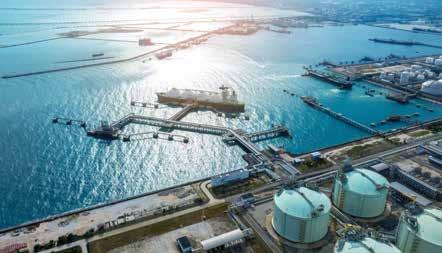
Norway, and Oman. After being offline since June 2022, Freeport LNG in the US came back online in February 2023 and was producing at full capacity by April.
New projects, the Coral South Floating LNG in Mozambique and the Portovaya LNG in Russia, were put into service by developers in 2022 and reached full production in 2023.
ccording to a report by the International Group of Liquefied Natural Gas Importers (GIIGNL), the global trade in liquefied natural gas (LNG) increased by 3.1% in 2023 to average 52.9 billion cubic feet per day (Bcf/d), up 1.6% from 2022.
Increased demand for natural
gas and increased export and import capacities propelled the expansion of the global LNG trade in 2023.
The United States Energy Information Administration (EIA) released a report stating that the expansion of LNG export capacity occurred mainly in the US, Mozambique, Russia, Indonesia,
Federal Reserve Chair Jerome Powell declared that he has no intention of resigning from his position as head of the US central bank before his term ends. This debunked claim was made by some Donald Trump supporters that Powell would lose his job very quickly if the former president could win back the White House.
Powell responded in the affirmative when
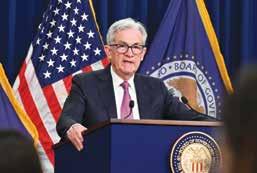
A third train was added to the Tangguh LNG export facility in Indonesia. By maximising the operational effectiveness of their current LNG plants, Norway and Oman enhanced their capacity for LNG production.
The United States surpassed all other countries as the world's top Liquefied Natural Gas exporter, with a 12% rise in exports from 2022 to 2023.
asked at an event if he planned to finish his term as chair, which ends in 2026.
If Trump, the Republican, defeats incumbent President Joe Biden on November 5, the comment may pave the way for further enmity between the two men.
The tense relationship between Powell and Trump will come under more scrutiny should the Republican Party win back the presidency.
Powell was chosen by Trump to lead the central bank, a position he took on in early 2018. Former President Barack Obama had initially appointed Powell to the Fed Board of Governors.
Not long after, Powell became Trump's enemy, as he blasted the central bank for raising interest rates in Powell's first year in office.
Powell was chosen by President Trump to lead the central bank, a position Powell took on in early 2018
The IMF
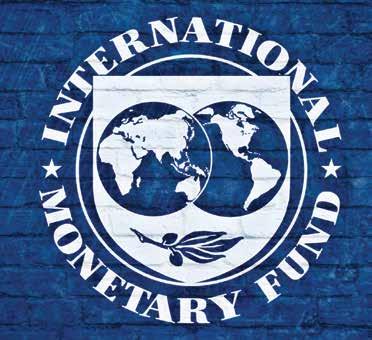
The International Monetary Fund said that 2023's gross capital inflows into emerging markets, aside from China, amounted to $110 billion, or 0.6% of their GDP, the highest amount since 2018.
The results demonstrate some resilience among emerging markets despite sharply higher interest rates that have drawn money into dollar assets.
The report is part of the IMF's External Sector Report on currency, capital flows, and financial imbalances. In the report, the IMF stated that net inflows of foreign direct investment have been more stable while emerging markets have seen a decrease in more erratic net portfolio inflows.
China experienced net capital outflows during the 2022–2023 period, including net negative FDI inflows, according to the report.
Meanwhile, in a report, the International Monetary Fund stated that the baseline projection is for the global economy to grow at the same rate of 3% in 2024 and 2025 as it did in 2023. It is anticipated that growth in advanced economies will accelerate slightly, from 1.6% in 2023 to 1.7% in 2024 and 1.8% in 2025.
However, growth in emerging markets and developing economies will slow down slightly, from 4.3% in 2023 to 4.2% in 2024 and 2025.
According to government data, services costs drove an unexpected increase in US wholesale prices in June. The Labor Department reported that the producer price index (PPI) increased by 0.2% in May after an earlier reported decline was corrected.
Despite a lower-than-expected consumer inflation reading that stoked expectations of an early September interest rate cut by the US Federal Reserve, the figures have been released.
The Federal Reserve has been fighting to keep interest rates high in order to push stubborn inflation back to its longer-term 2% target.
The consumer price index, which is a key measure of inflation, rose by 3.0% compared to a year ago, according to government data. This marks a decrease from May's 3.3% increase. However, the Labor Department reported that the overall index in the PPI report increased due to a 0.6% rise in service costs.
The report further stated that the PPI increased by 2.6% in June compared to the same month last year, marking the biggest gain since rising by 2.7% in March 2023. However, after increasing by 0.2% in May 2024, an underlying measure that excludes trade, energy, and food services remained unchanged in June. Experts anticipate that the Fed will cut rates in September.

Analysis
GBO Correspondent
Between March and April 2020, passenger car sales in Europe decreased by more than 65% on a monthover-month basis
The Global Automotive Industry Market Size, as of March 2024, had been valued at $3,564.67 Billion in 2023 and the Worldwide Automotive Industry Market Size is expected to reach $6,861.45 Billion by 2033, at a Compound Annual Growth Rate (CAGR) of 6.77%, according to a research report published by Spherical Insights & Consulting.
The latest figures suggest that the industry is thriving. However, things were not so rosy in 2020, at the height of the COVID pandemic. There was a demand reduction, as the countries went into the lockdown and the global economy came into a standstill. China saw a sharp decline in car sales. Sales in Europe and the United States had collapsed. Between March and April 2020, passenger car sales in Europe decreased by more than 65% on a monthover-month basis.
Now, the crisis has become a thing of the past, as the Asia-Pacific region is dominating the automobile sector. China holds the largest market share in the region, followed by India and Japan. Asia-Pacific's automobile market is likely to grow at the fastest rate, given the pace of the region's economic growth, along with the faster adoption of electric vehicles (EVs).
The United States too, is expected to dominate the regional market, followed by Canada and Mexico. The US government's policies supporting electric vehicles and extensive supporting infrastructure are having a positive impact on the country, which is home to major automakers.
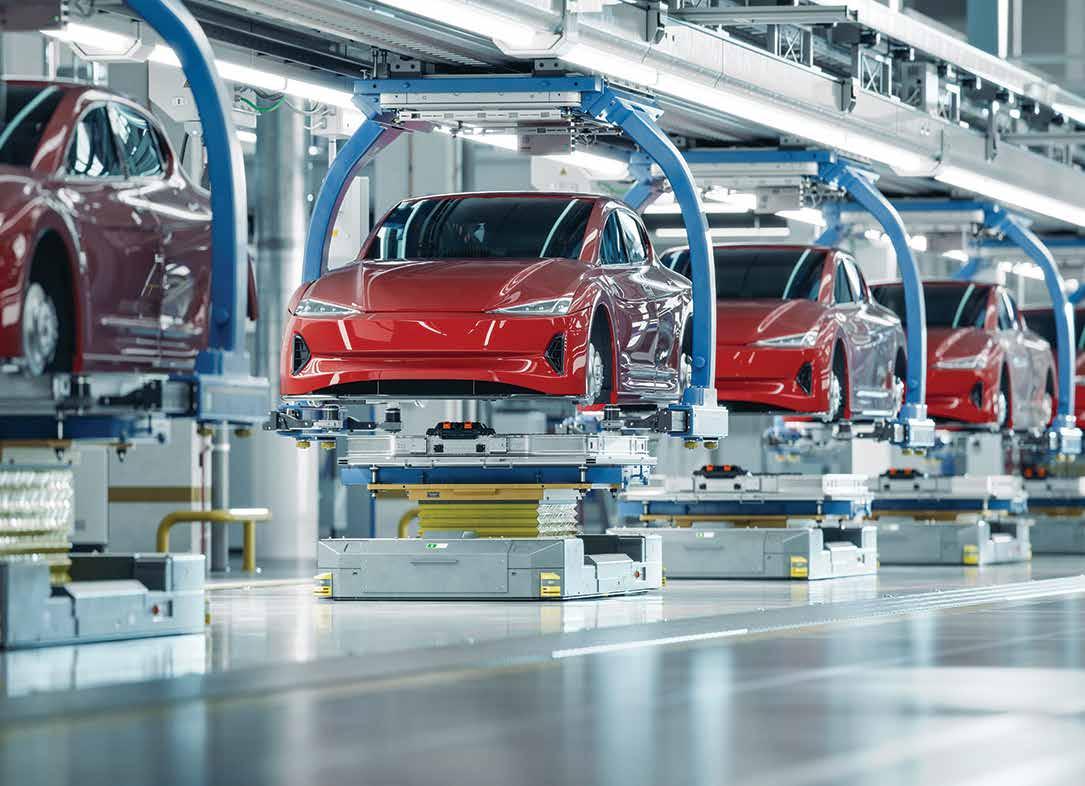
With few vehicles in showrooms during the COVID period, automakers and dealers were able to scrap most sales incentives, leaving consumers to pay full price. As per the New York Times, some dealers even added thousands of dollars to the manufacturer’s suggested retail price, and people started buying and flipping indemand cars for a profit.
However, as the economic activities resumed and lockdowns started easing, semiconductor supplies too came back to healthy levels, causing automobile production to rebound and dealer inventories to grow further. However, there is another problem in the form of higher interest rates, which has dampened demands again. Due to this, automakers are again scrambling to keep sales rolling.
Wes Lutz, owner of Extreme Dodge in Jackson, Michigan, told the NYT that he had several Dodge
Challengers and Chargers that were eligible for $11,000 discounts from Stellantis, the manufacturer of Dodge, Chrysler, Jeep and Ram models. The automaker is also offering discounts of up to $3,600 on certain versions of the Dodge Durango sport utility vehicle.
As per Lutz, the sector is heading back towards the phase of incentives and overproduction. As per the reports, despite high borrowing costs, vehicle buyers are still looking to reap benefits from reintroduced financing offers and other incentives like discounts and dealer cash. Cash-back offers, subsidised loans and other incentives are emerging as potent tools for selling cars. Automakers and dealers are comfortable with monthly payments that are more affordable and ease the impact of high interest rates.
The recent inventory shortages and consumers’ preferences for large vehicles have pushed the average purchase price of new vehicles to just under $47,000,
The growing number of incentives on new vehicles has helped in the price reductions of used cars and trucks. In April 2024, used car prices declined nearly 7%, according to the Bureau of Labour Statistics

and the average monthly payment to $735, according to the market researcher Edmunds. The average interest rate on used car loans was 11.6% in April 2024 and as per the company, consumers are no longer in the situation to afford cars without substantial incentives.
Will the incentives help?
Yes, we are living in a high interest rate regime. Yes, we are undergoing a "cost-ofliving crisis." This means that to keep up with its profit and sales targets, companies will continue to indulge in aggressive price wars, apart from offering customerfriendly incentives. However, if the game is taken to the extreme, it will erode automakers’ profits and create a sales surge that will be followed by a sudden demand drop, since most of the first-time
car buyers will be awaiting the "Discount Season."
"Two decades ago, the industry went on an incentive binge. General Motors for a time sold cars at the heavily discounted prices it previously offered only to its employees. Extreme discounting helped weaken GM and Chrysler before they filed for bankruptcy in 2009 during the financial crisis," reported NYT. However, repetition of the same story looks unlikely now. At the end of May 2024, automakers had almost 2.9 million cars and light trucks in stock, about one million more than the corresponding month in 2023, according to Cox Automotive, a market researcher. By comparison, there were 4.1 million vehicles in stock in 2019, according to Automotive News.

So, while reaching the pre-COVID mark looks difficult for the automakers (in terms of inventory numbers), things are certainly looking better in 2024.
"Toyota, Honda, Subaru, and GM’s Chevrolet and Cadillac brands have kept tight reins on their inventories and in general have not yet elevated incentives significantly. But Ford, Lincoln, Dodge, Chrysler, Nissan, Volvo and several other brands have higher stocks, enough to last over 100 days at the current rate of sales. They’re offering some big incentives, but mostly targeted at specific models, and sometimes specific versions of certain models. Ford, for example, is offering $5,500 off its Escape SUV, but only on the 2023 models that remain in dealer stock. Stellantis is offering $4,000 cash back on the Ram pickup, but it is limited to the 1500 Classic version. Volkswagen is offering interest-free financing on the 2024 Taos small SUV, but not on its other models," NYT noted.
“So far we’re not seeing the acrossthe-board incentives that we had in the past,” said Charles Chesbrough, a senior economist at Cox Automotive.
The growing number of incentives on new vehicles has helped in the price reductions of used cars and trucks. In April 2024, used car prices declined nearly 7%, according to the Bureau of Labour Statistics.
Among the most heavily discounted models currently are electric vehicles. Consumers’ enthusiasm for those models has ebbed worldwide, due to concerns about the higher prices and the challenges of keeping them charged, especially on road trips.
To counter this, Volkswagen is offering discounts of up to $18,750 on leases on its 2023 ID.4 line-up. The price tag includes the $7,500 US federal tax credit, which can be rolled into leasing deals under the Inflation Reduction Act.
When discussing other customerfriendly options, the Chevrolet Blazer
EV, Cadillac Lyriq, Kia EV6, Volvo XC40 Recharge hybrid, and Ford F-150 Lightning electric pickup are all in the competitive race. Tesla, led by Elon Musk, initially raised vehicle prices multiple times during the COVID-19 period but has since corrected course by reducing them over the past year and a half. Additionally, the company is offering 0.99% loans on its Model Y SUV.
"The incentives come on top of other trends that are helping reduce the price of electric vehicles, including falling manufacturing costs and rising competition. Increased discounting is helping tempt what are known in the industry as “want buyers,” consumers who don’t need a new car but are drawn by new technologies, design or features," NYT added.
“You have your ‘need buyer,’ whose car had died or needs a lot of expensive repairs, and they have to get a new vehicle. But a lot of those ‘want buyers’ went away when interest rates went up, and now incentives are bringing some of them back” said Adam Silverleib, owner of a Honda and a Volkswagen dealerships outside Boston.
Regarding the "want buyers," NYT reported about Brian Pawlowski, a Michigun-based digital marketing executive, who had been driving a 2017 Chevrolet Volt plug-in hybrid that had only 55,000 miles on the odometer, yet was itching to get a fully electric model.
He began looking for customer-friendly EV deals and found a two-year lease on a Hyundai Ioniq 5 SUV. The deal came with a $13,000 discount and other terms that left him with a monthly payment of $369 for a vehicle with a sticker price of $52,000. And the deal was too lucrative for him to let go. So he went after it and got the vehicle.
Cars sold worldwide in 2023 (In Million Vehicles)
Source: Statista

GBO Correspondent
One of the most important announcements to come out of the real estate market recently was the update to the Dubai RERA (Real Estate Regulatory Agency) Rental Index. Tenants currently have to deal with inevitable rent increases.
The RERA calculator, recalibrated in March 2024, has become a representative of open-market pricing, as it will be revised periodically for certain communities and buildings to reflect current market rental rates. It shows whether or not a rent increase is allowed and uses criteria such as location, property type, current rent and number of rooms, and works by comparing properties with similar ones nearby.
As per the property consultancy Cushman & Wakefield, rents in Dubai surged by 19% in 2023, compared with 27% in 2022. It also said that many tenants were opting to stay put because rental increases during renewals are much lower compared to signing new leases, but several renewing in 2024 will face higher rent due to the adjustment in the RERA calculator.
In this article, Global Business Outlook will decode the intricacies of the RERA calculator and its impact on Dubai’s real estate landscape.

According to Cushman & Wakefield, Dubai is currently seeing a twotiered rental market, with a widening gap between new contracts and lease renewals
Total property sales in Dubai from 2013 to 2022 (In Billion USD)
Source: Statista
Dubai tenants who have been getting lease renewal requests are seeing sharp rent increases as landlords are now trying to bring rates to ‘market averages’. The rent hike is touching the 20% ceiling.
The trend has been prominently felt in the mid- to upper-mid-market residential communities, rather than in the premium end of the rental market. The development comes immediately after the RERA Rental Index witnessed a revision in its average rental values for popular residential locations in Dubai.
Till a few months back, most of the rental averages in the RERA index were skewing towards 2020 figures or thereabouts. However, as per the market sources, there has been a comprehensive revision to bring the index closer to the Dubai rental market dynamics.
"Even earlier, the demand pressure for rental options from a fast-expanding resident base had landlords going in for sizable hikes. It was easy if it was a brand new building and thus getting first-time residents. In older buildings, landlords were forcing up rates on renewals, and when they were not getting it, forcing evictions," Gulf News reported.
Citing the RERA index update as 'more of a catching up' with actual market rates, an estate agent remarked, "This implies that going forward the number of eviction notices can go down and the pace of rental increases will also slow as the Dubai rental market levels up."
According to the property portal Dubizzle, the average yearly rent for studio, one- and two-bed apartments in Dubai Marina increased by 18.33%, 17.39% and 17.99%, respectively, in 2023.
As per the market analysts, it's unlikely that prime areas in the city will keep recording that kind of rent growth, unlike in the mid-market residential districts.
Talking about mid-market, let's take a look at the Jumeirah Village Circle (JVC), which has its share of upper-mid options
too. There, the average yearly apartment rent has increased by 32%, thereby making it the "biggest rise in the affordable rental apartment category," according to Dubizzle, which stated, “The average annual rent for flats in JVC has jumped from Dh50,000 in 2022 to Dh66,000 in 2023.”
Also, businesses are now preferring to own commercial properties amid rising rentals, a route followed by the residents in the past to beat the rising rentals. This trend has been one of the key drivers of Dubai’s residential property market postCOVID.
Robert Thomas, head of agency at Cushman & Wakefield Core, told the Khaleej Times, “We particularly see local entities who know that their growth plans can be accommodated within the same space/building and they do not want to go through sharp rental increases or eviction notices as seen in the residential market. However, this trend is generally limited to local or regional entities, as multinational corporations and global occupiers typically do not own their real estate."
"Real estate local brokerage entities will be an example that have moved into owning their space, perhaps linked to their ability to source attractive rates through their networks. This has been reflected in increased office sales market sale transactions which grew 24% year-on-year in 2023, accompanied by a 23% increase in median sales prices," the analyst added.
"Last year (2023), we observed rental ranges widening for some areas by increasing the top end of the allowed price increase. The residential rental market is on an upswing stage of the cycle. Therefore, increasing the upper end of the permitted rental range allows landlords to increase their rates closer to prevailing market rents and improve their yields in the process," explained Haider Tuaima, director and head of real estate research at Dubai-based ValuStrat, while interacting

with The National.
Cherif Sleiman, chief revenue officer of Property Finder, said the recent change in the rental index also reflects RERA's efforts to balance a fair rent increase across different communities "while fostering a healthy environment for investors, ensuring competitive rental yields aligned with global standards."
With many tenants with historically low rents set to face significant increases in their next renewal, John Lyons, managing director at Dubai-based Espace Real Estate, said, "This will increase the churn rate of rental stock within many communities, while also accelerating the trend of 2023, whereby many tenants decided to buy, opting for the lower monthly costs associated with home ownership."
"Although the updated rent calculator will inevitably cause some level of disruption for many tenants, the great pivot of housing stock from the rental sector to the end-user sector will help to create increased levels of stability for Dubai’s residential property market over the longer term," Lyons stated.
Jacob Bramley, senior leasing manager at Dubai-based Betterhomes, told The National that the consequence of the RERA Rental Index update could be two-
pronged: any increase may prompt tenants to vacate their property to save money, which in turn would allow landlords to re-rent at a higher price, offering better return for their investment.
However, this could also lead to increased demand in "newer" and developing communities that offer better value for money, as tenants opt to downsize or move further from their ideal search location.
According to Cushman & Wakefield, Dubai is currently seeing a two-tiered rental market, with a widening gap between new contracts and lease renewals. The reason behind this is the trend of tenants opting to stay put due to rental increases during renewals, as this move is more lucrative than signing new leases, with the latter being decided by the RERA calculator.
Prathyusha Gurrapu, head of research and consultancy at Cushman & Wakefield, said, “Villa rents have risen 16% year-onyear and are up by more than 17% from their 2014 peak values, while apartments have seen a sharper increase at 19% yearon-year – albeit apartment rents are 2% below their 2014 peak values. We expect rental rises to continue for new leases in 2024, particularly in established central locations, where high occupancy levels
“Villa rents have risen 16% yearon-year and are up by more than 17% from their 2014 peak values, while apartments have seen a sharper increase at 19% year-on-year –albeit apartment rents are 2% below their 2014 peak values"
- Prathyusha Gurrapu
Dubai is continuing to witness strong population growth, with an addition of 100,240 residents in 2023. The city currently has more than 3.65 million residents. With the 2040 Dubai Urban Master Plan, the city’s resident population will likely increase to 5.8 million in the next 17 years
will exert upward pressure on rent. That said, with a greater number of deliveries in the sub-urban locations, we expect rental increases to be moderate in the newly handed over districts.”
Apartment rents in Dubai increased between 20%-30% in 2023, according to data compiled by Better Homes. While average villa rents also increased in communities across Dubai, these rises were typically in the range of 10%-20%. And yes, affordable apartment districts have witnessed the sharpest rental increases in the past 12 months due to relatively lower bases.
Demand has, however, remained on the higher side, with more people opting to buy their own homes, Gurrapu noted further.
More than 39,400 units were reportedly handed over to owners in Dubai, in 2023 (the highest number of handovers since 2020).
“In 2024, while there are more than 65,000 units slated for handover, our conservative estimates are at around 32,000 units, of which 76% are expected to be apartments and 24% villas,” Gurrapu observed.
Dubai is continuing to witness strong population growth, with an addition of 100,240 residents in 2023. The city currently has more than 3.65 million residents. With the 2040 Dubai Urban Master Plan, the city’s resident population will likely increase to 5.8 million in the next 17 years. That reflects an increase of more than 2.15 million residents.
As per Gurrapu, Dubai will need nearly 30,000 residential units consistently every year until 2040.
"Although we don’t think the market will experience sharp levels of price increases as seen in 2023, we think there will be moderation in the market as the difference between ask and bid prices widens, pricing end-users out of the market," Gurrapu continued, while stating, "With very limited post-handover payment plans now seen in the off-plan market, and the potential lowering of the interest rates later in 2024, these are expected to support the secondary sales market and help moderate the sales price increases."
In case the apartment vacancy rate goes higher due to the upward revision of the

RERA Rental Index, will real estate prices decline? Experts believe in this possibility, but it all depends on how eager the market is to find new tenants.
However, some experts don’t want to buy into this logic, as they feel that the price increases won’t be as sharp at the top end of the market as there has been. They also anticipate a slight increase in prices in the lower and mid-range as more tenants move out in search of more reasonably priced options.
Luxury Property Leasing Director Simon Boden said, "Affordability won't be a problem when it comes to rent increases above a particular threshold. The timeline, on the other hand, will be the issue. For instance, if the RERA Index permits a 20% increase in rent for a tenant paying Dh150,000, that would be an additional Dh30,000 annually. Not immediately, but over the course of the year, that rent might still be reasonable."
“Renters must have time to produce that cash flow. As a result, there has been pressure for longer payment terms and more checks. As an alternative, tenants may be comfortable with receiving a single check for the entire amount of the previous rental price, with the additional amount spread out over a few months. Although landlords currently have the power to request a higher rent at lease renewal, they must collaborate with tenants. If a tenant is unable to pay a 20% premium upfront, it makes little sense to evict them and leave the apartment unoccupied for three months while you hunt for a higherpaying tenant who can pay the entire amount due in one go. In actuality, many renters will have to make some difficult choices, such as selling their current residence or purchasing a home in order to avoid any problems with rent,” Boden added.
Meanwhile, in November 2023, S&P predicted that house prices would rise by 5% to 7% in 2024 and as per Tatiana Leskova, associate director of Corporate Ratings at S&P, there is no sign of a
slowdown in Dubai real estate prices.
Dubai's real estate market is thriving, as evidenced by the rising momentum in rents, property values rising in tandem with the construction of new highrise buildings, and a sharp increase in property transactions. The owner of a one-bedroom apartment in Dubai Marina at Colife saw a notable 21.2% increase in monthly income to $2,970 over the previous year.
According to Leskova, owners should expect even larger returns in the neighbourhood of $3,415 per month in 2024. Real estate experts predict a steady demand for residential space in Dubai due to the city's growing population and ongoing influx of international professionals.
Betterhomes CEO Richard Waind stated that the tenants who have lived in their properties for over two years will see a bigger increase when renewing their lease due to the changes. He estimates rents could rise 10%-20% in the short term for areas that have experienced significant rental growth in the past two years, such as popular villa communities and waterfront apartment buildings.
However, Waind also believes the updated RERA calculator will help stabilise neighbourhood rents long-term. Before the revision, there was a large gap between benchmark renewal prices set by RERA and actual market rents, especially for coveted neighbourhoods. This discouraged tenants from moving out and led to a lack of supply on the market. By making renewal costs more reflective of current values, the new calculator may motivate more tenant turnover and open up more listings.
Dubai's real estate market is thriving, as evidenced by the rising momentum in rents, property values rising in tandem with the construction of new high-rise buildings, and a sharp increase in property transactions
Analysis
GBO Correspondent
Campaign group
Which? found in July 2023 that over half of the 4,000 people it surveyed faced at least one broadband connection problem in 2022
The United Kingdom government, in March 2024, announced that over one million homes, businesses and public buildings would be able to access the "best internet speeds on the market" as a result of the reported rollout of faster, more reliable broadband.
The government also outlined details of the UK Research and Innovation’s (UKRI) £70 million "Future Telecoms Programme," funded through the UKRI Technology Missions Fund and supporting one of five critical technologies, which would see 16 UK projects sharing £22 million to support development and commercialisation of cutting-edge tech solutions and lay the groundwork for the "networks of the future."
If the above news shows that the broadband connectivity expansion in the European country is accelerating at a steady pace, there is another side of the same coin. As per The Register, by September 2023, an estimated 22 million Brits endured broadband outages of three hours or more, and are paying a higher monthly subscription for the pleasure.
The statistics were compiled by the price comparison website Uswitch. They surveyed 2,000 subscribers about their broadband issues and found that 41% experienced connectivity failures lasting more than 180 minutes.
The stats equated to a “staggering 21 million UK consumers” and are a major increase on the 12 million who reported similar woes in the 2022 annual broadband outage survey.
Understanding the problem
Uswitch reckons almost one in five reported that outages occurred during work hours, with 15% of respondents facing a total connectivity stoppage. A third that lost connectivity were doing so at least once a month, and a quarter moaned it continued for three hours or more a week, or 6.5 days of downtime over 12 months.

Only 22% were informed about receiving compensation, perhaps because almost half didn't even realise they were entitled to it, as per The Register. This is against a backdrop of rising broadband prices, which went up on average by 15% in April.
Campaign group Which? found in July 2023 that over half of the 4,000 people it surveyed faced at least one broadband connection problem in 2022. Kester Mann of analyst CCS Insight warned in 2023 that more inflationlinked pain could be coming, saying that telecoms "price rises each April are now commonplace in the UK," with most operators "using an inflation-linked calculation and adding up to 3.9 percentage points. The method received relatively little attention when inflation was low, but now that it's above 10%, the highest level in 40 years, the impact is far greater."
Customer awareness crucial
Broadband customers suffering service failures may be
missing out on money they are owed because they are unaware of their rights to automatic compensation. Under the telecoms regulator’s “automatic compensation” scheme, customers should receive set daily payments of up to £9.76 if an internet outage is not rectified after two days, or if an installation date is missed.
However, campaigners and activists say that, as complaints rise, unclear rules are allowing companies to get out of paying up, and that customers lack the information they need to challenge them.
The Guardian reported about an individual named Cameron Park, who was left out of pocket by more than £600 after British telecom giant BT went back on its initial pledge to compensate the person for a five-month delay to his new broadband service.
The installation was scheduled for July, but nothing happened. At the November end, the person was told that he would have to pay an unspecified excess construction charge of up to £3,000 before the work could proceed.
Source: Statista
When he refused, BT cancelled his contract. Its sister company, Openreach, which manages the broadband network, admitted the charge had been raised in error after the Observer intervened. Park was finally connected in January 2024, and BT agreed he would be compensated for 141 days of delay.
"Under the automatic compensation scheme, he was entitled to £5.83 a day (the compensation level at the time), amounting to £822. But BT then claimed it had pledged the sum in error, and insisted he accept £215. It stated that it was not liable for 75% of the delay, because it was caused by an unspecified third party," the Guardian reported further.
Ofcom’s code of practice says that providers are liable for compensation whether or not connectivity installation delays are caused by third parties. However, there are exemptions, if a law or regulation will have to be breached to avoid a delay. Providers are expected to explain to customers why a payment is not due, which BT did not do.
“At no point, through the whole process, was a third-party delay mentioned, and nor is this reason for exemption mentioned on
BT’s own website. I was, instead, repeatedly informed, in writing, that I would be paid the full amount,” Park said.
The Observer, another British newspaper, asked for details from BT on Park's case. The telecom giant was mentioned by the media outlet in these words, "Park’s long wait was due to health and safety requirements involving a power company, and this was not mentioned due to safeguarding. It then claimed the culprit was a landowner who had to grant permission for cables to be laid."
"Park took his complaint to the Communications Ombudsman, whereupon BT stated that he was to blame for 107 days of the delay because he had not accepted the erroneous excess construction charge. Compensation is not due if it was the customer who caused the delay. The ombudsman therefore ruled in BT’s favour," it continued.
BT’s claims were eventually questioned by the Observer. Park was awarded only an extra £64. The telecom venture said the rules relating to exemptions were correctly applied, but, “Having reviewed this case further, and the information available to us, we acknowledge there is an additional period of automatic compensation to be paid and we’ve apologised for this oversight."
BT has since agreed to pay another £100 as a “goodwill gesture.” Consumer advice group Broadband Savvy says customers are being let down by opaque rules and a “toothless” ombudsman.

“We’ve seen a 33% increase in requests for help this year, compared to 2023. There have been numerous instances where the ombudsman has found in the ISP’s favour, despite it leaving the consumer offline for months for no good reason. And when it does uphold a customer complaint, it has no real power to force the provider to act,” the group's founder Tom Paton said.
The ombudsman, on its part, insists that it reviews every complaint fairly and impartially.

“Our role is either to put the consumer back in the position they were in before the issue occurred, or if suppliers have not caused consumer detriment, then no action will be taken,” it stated further.
According to consumer rights expert Martyn James, "It is the voluntary code of practice that is toothless, and should be replaced by legally-binding regulations. If the rules are open to interpretation, businesses can get out of paying. Most customers will give up when turned down with a poor excuse, or offered a rubbish settlement, as they’ll take the ISP’s word for it.”
Ofcom told the Observer that it was the ombudsman’s role to judge whether an exemption had been applied unfairly. It said the scheme had increased the amount of compensation given to customers fourfold, with £60 million paid in 2022,
and that a voluntary code of practice was the “quickest and most proportionate” way to get companies to sign up.
However, it admitted “unforeseen issues” could arise, and said customers were encouraged to get in touch with problems to help it monitor compliance.
“We are aware there are complications with a small number of cases of automatic compensation, and this is something we are looking into. Providers signed up for the automatic compensation scheme are required to pay out to customers when there is a delay to the start of a new service. And this includes if the delay is caused by an event beyond a customer’s, or the provider’s, control, such as anything related to a third party,” it concluded.
“We’ve seen a 33% increase in requests for help this year, compared to 2023. There have been numerous instances where the ombudsman has found in the ISP’s favour, despite it leaving the consumer offline for months for no good reason”
- Tom Paton
The largest mortgage lenders in the United Kingdom decided to abide by a set of guidelines known as the Mortgage Charter in 2023
Throughout 2022 and 2023, the term "cost-of-living" hogged the limelight, and even now, domestic prices and the risks to food production remain elevated across the economies. Although inflation has been declining in response to many central banks’ interest rate hikes, countries are still facing elevated price pressures. People are still finding it difficult to pay their bills. In the year ending in February 2024, private sector rents rose by an average of 9%, and rising interest rates resulted in higher mortgage payments for many.
You might worry right away that you won't be able to keep your house if you find yourself in financial trouble, but being aware of your

resources and legal rights will help you get through this trying period.
Your rights as a renter are determined by the kind of tenancy you have. You almost certainly have an assured shorthold tenancy if you rent from a private landlord in England (Wales and Scotland have different laws). This means that your rent is determined by the amount you and your landlord agreed upon. Either a fixed term or a periodic agreement that rolls over from month to month was agreed upon. Whichever kind you have, if you don't make a payment on time, your landlord cannot kick you out right away.
Most tenants with fixed-term leases have a formal contract with beginning and ending dates.

Source: The Global Treasurer
If you fail to make a payment and there are over two months left on your lease, your landlord will have to go through an extended legal procedure.
In order to reclaim the property, they must first give you a section 8 notice and then request a "possession order" from the court. The court will typically issue an outright possession order if you are more than two months behind on your rent, usually with a two-week possession date. The court will be more lenient if, at the time of the hearing, you have not missed more than two months' rent. The court may decide not to issue a possession order or may issue a suspended order if you agree in court to pay the full amount of rent that is owed. After that, the arrears must be settled. The legal procedure is typically completed more quickly if your tenancy is month-to-month and you have been there for four months or longer. With a Section 21 notice, your landlord can evict you, but you are allowed to remain until the date specified in the notice. Additionally, as soon as you receive a Section 21 notice, you can ask the council for assistance in finding a new place to live. Your landlord is required to give you a Section 8 notice in place of a Section 21 notice if you have been residing there for less than four months.
A good track record makes most landlords reluctant to evict their tenants. They might be willing to give you more time to pay, since finding a new one costs money and time. Make contact with them as soon as you can. If you incur housing debt, your rights are stronger in Scotland, and they vary depending on when you started renting in Wales.
The government website outlines the legal procedure if your landlord wishes to begin the eviction process, and the housing charity Shelter England offers clear guidance on receiving assistance with rent. Legally speaking, you can stay in your house until you obtain a court order compelling you to do so. However, continuing to live there can result in
additional rent arrears that you will still need to pay off.
If you are receiving welfare benefits and are finding it difficult to pay your mortgage, you may be eligible for assistance with paying the interest on up to £200,000 of your mortgage. A government loan called “Support for Mortgage Interest” is due back with interest when you sell your home. This is limited to recipients of specific benefits. Lenders are required to follow a preaction protocol if you miss a mortgage payment, which includes trying your best to work out a plan to pay back the arrears. Repossession ought to be the very last option.
The largest mortgage lenders in the United Kingdom decided to abide by a set of guidelines known as the Mortgage Charter in 2023. The charter recommends steps like extending the mortgage term to lower payments, providing a switch to interestonly payments, and granting temporary payment suspensions to people who are struggling financially.
In England and Wales, the court must determine that you can pay both your regular instalments and any arrears within a reasonable time frame, which is the remaining mortgage term. The amount that you must pay in addition to your regular mortgage payments in order to pay off the arrears will typically be determined by the judge.
As long as you are able to make these payments, the possession order will be suspended. The court may grant you an outright possession order but give you a 14or 28-day window to find another place to live if you are unable to persuade it that you can make the payments within a reasonable amount of time.
Selling your house instead of having it repossessed might make sense in certain situations. If you think you might end up homeless, you might be able to get assistance from your local council.

The “Housing Loss Prevention Advice Service” offers free emergency legal advice and representation in most courts on the day of possession hearings to anyone who is in danger of losing their home. The service also offers free legal advice on housing, debt, and welfare benefits. Advice on handling late mortgage payments is also available from Shelter.
Meanwhile, an examination of current accounts at a major bank indicates that annual spending on mortgages and rent increased by 6.3% in May 2024.
According to research by Barclays, this growth rate was higher than the increase of
3.6% the previous month. For this study, the bank used the transactions from its current account to identify direct debits and bank transfers made to private landlords and mortgage lenders.
Several lenders were covered by these transactions, including Barclays. Although the data showed an increase in housing costs in comparison to 2023, the month-to-month variation appeared to be insignificant, suggesting that consumers might not experience a decline in their standard of living in the near future, particularly in light of the repeal of the Ofgem energy price cap in April 2023.
Selling your house instead of having it repossessed might make sense in certain situations. If you think you might end up homeless, you might be able to get assistance from your local council
Advertorial
Panda Retail Company
Panda Retail Company envisions itself to be the sustainable leading retailer, innovating to delight the communities it serves every day
Established in Riyadh in 1978, Saudi Arabia-based Panda Retail Company has cemented its position as one of the main retail chain businesses in the Middle East and the biggest grocery retailer in the Kingdom. The company, which has over 188 stores in 45 cities, mainly operates two kinds of outlets, Hyper Panda (larger stores) and Panda Supermarkets.
With more than 100 million customers visiting its stores every year, Panda Retail operates four main distribution centres in the Gulf nation with a fleet of more than 500 temperature-controlled trucks to deliver over 30,000 SKUs of food and non-food products to its stores.
Panda Retail Company recently got honoured with the prestigious title of "Best Grocery Retailer in Strategic Partnership Implementation - Saudi Arabia 2023" by the esteemed Global Business Outlook Awards. This recognition demonstrates the retail chain's leadership’s unwavering commitment to excellence and forming impactful strategic partnerships that drive growth and innovation in the grocery retail sector.
Dr. Bander T. Hamooh Chief Executive Officer

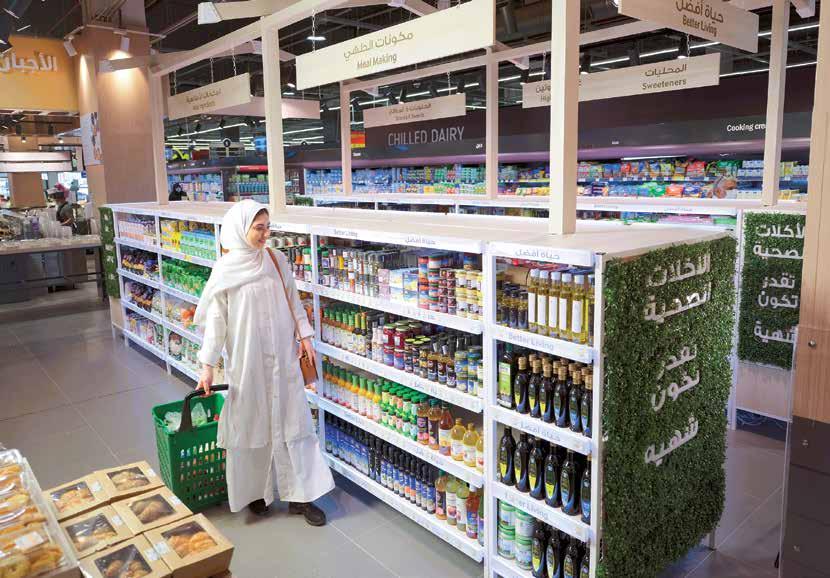

"This award is a testament to the hard work and commitment of all members of the Panda team in addition to our valued Partners, together we have achieved ongoing success," the company told the Global Business Outlook.
Ensuring a better life
Panda Retail envisions itself to be the sustainable leading retailer, innovating to delight the communities it serves every day. The company’s mission is to empower its colleagues, customers, and communities to improve their quality of life by creating value and enhancing wellbeing.
To fulfill its vision and mission, the company is banking on five operational principles: Ownership, Agility, Teamwork, Customer Excellence and Integrity.
When Global Business Outlook asked Panda about how it keeps itself a league above its competitors in the industry, Panda Retail credited its relentless commitment to customer-centricity and continuous innovation behind its retail sector rise. The same attributes ensured honours like GBO Awards and Retail Asia Award for "Best Retail Market Design" in 2023 for Panda Retail Company.
"Our differentiation stems from our deep understanding of customer needs, which is facilitated
by our award-winning market designs. These designs are not just aesthetically pleasing but are crafted to offer an exceptional and enjoyable shopping experience. Moreover, we prioritise leveraging the latest technologies to enhance the consumer experience. Partnering with a technology solution company, our Panda application, powered by cuttingedge technologies, makes shopping easier and more convenient for our customers," the company told the correspondent further.
"One key aspect that sets us apart is our focus on offering the best value to our customers. Through advanced artificial intelligence programmes, we analyse market prices to ensure that our customers always receive the best possible prices on products. Additionally, our expansion efforts in various regions of the Kingdom, with the opening of numerous markets in 2023, demonstrate our commitment to providing exceptional shopping experiences to customers across new areas," Panda Retail added.
Game changer called 'Four Season'
Panda Retail introduced the above concept to revolutionise the customer experience within its outlets. The aim was simple here: to create a shopping environment centred around freshness, apart from

providing a unique experience for the company’s customers.
Panda Retail excels in leveraging customer data and advanced analytics to create personalized offerings and communication strategies that cater to the diverse needs of consumers
"To achieve this, we took into consideration the entire customer journey within our stores. We understood that every step, from the moment a customer entered our store to the point of making a purchase, mattered. By understanding the customer decisionmaking process, we were able to make informed changes to improve their overall shopping experience," Panda Retail noted.
In 2021, Panda launched the Customer Experience Revival (CXR) programme, aiming to redefine the way its customers experience its stores and ensure a seamless shopping journey.
"Through this programme, we implemented various initiatives and strategies to elevate the customer experience within these areas. Through prioritised factors such as enhancing product quality, improving product display, optimising the layout and organisation of sections, and training our staff to better assist and guide customers. Our award-winning CXR programme focused on providing our
customers with a more enjoyable and convenient shopping experience," the business added.
Aligning with Saudi Arabia’s "Vision 2030" economic diversification agenda, which aims at increasing the quality of life in the Kingdom, Panda aims to extend its hands to the community and elevate its already high-quality standards of customer experience to an even higher-level deserving of the customer.
The CXR programme has been fully implemented in over 75 stores across the Kingdom. As a result of offering pleasant and seamless shopping experiences, Panda successfully increased customer satisfaction while fostering loyalty.
Excellence at tech front Panda Retail excels in leveraging customer data and advanced analytics to create personalized offerings and communication strategies that cater to the diverse needs of consumers.
"This initiative is the utilisation of machine learning and artificial intelligence technologies, which analyse

vast amounts of customer data derived from over 100 million purchases annually. By studying purchasing patterns, preferences, and behaviours, Panda gains valuable insights into individual customer needs and preferences. Recognising that every customer is unique," Panda Retail added.
The retail company is also striving to tailor its offerings accordingly. Whether it's a family with specific shopping habits or individual customers with distinct preferences, Panda ensures that each segment receives personalised offers and experiences that resonate with them.
The company maintains a secure safeguarding the privacy of over 14 million distinguished customers.
Panda Retail Company stands at the forefront of technological transformation with its pioneering concept of "Phygital," which is all about the seamless integration of physical and digital experiences, redefining customer engagement in the process, while setting new standards for the modern era.
Powered by machine learning and artificial intelligence, Panda analyses over 100 million purchases annually, gaining invaluable insights into customer preferences and behaviours. This data-driven approach ensures that each customer receives tailored offers and experiences that meet their unique needs. Recognising the diversity of customer requirements, Panda remains dedicated to inclusivity, ensuring that every individual, family, or demographic segment is
catered to with relevant and meaningful offerings. This customer-centric ethos has earned Panda the loyalty of over 14 million distinguished customers, a testament to its unwavering commitment to delivering value and satisfaction.
"Ultimately, Panda's journey towards Phygital transformation is guided by a steadfast commitment to placing the customer at the forefront of every decision. By embracing digital innovation, fostering meaningful partnerships, and prioritising customer-centricity, Panda is paving the way for a future where exceptional experiences and sustainable growth go hand in hand.”
In commitment to excellence in our business, Panda Retail Company continues to forge impactful strategic partnerships that drive growth and innovation in the grocery retail sector, the Panda remarked.
By collaborating with leading technology firms in the retail field, Panda is demonstrating its commitment to leveraging advanced solutions to meet evolving customer needs. Through these collaborations, the company is leveraging newer operational strength, apart from gaining access to new markets, enhancing operational efficiency, and introducing innovative solutions for its customers.
All these efforts resulted in the company being honoured with the prestigious title of "Best Grocery Retailer in Strategic Partnership ImplementationSaudi Arabia 2023" by the Global Business Outlook Awards.
The United States Securities and Exchange Commission (SEC) has granted preliminary approval to asset managers hoping to introduce exchangetraded funds linked to the spot price of ether for trading. The approval is contingent upon the applicants providing regulators with their final offering documents. Experts say that it is anticipated that all eight will launch at the same time.
After the introduction of nine US spot bitcoin exchange-traded funds (ETFs) in January 2024, the ether products would represent yet another significant victory in the cryptocurrency industry's drive to mainstream digital assets. Bitcoin is the largest cryptocurrency in the world, with Ether coming in second.
Industry sources who spoke on the condition of anonymity due to the SEC's confidentiality discussing the application process anticipate that eight asset managers,
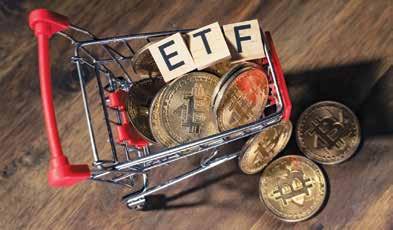
including BlackRock, VanEck, and Franklin Templeton, will likely have their applications approved by the SEC.
The decade-long battle with the SEC, which had rejected the products owing to concerns about market manipulation, culminated in the launch of spot ETFs tracking the price of bitcoin in January. After losing a legal challenge from digital asset manager Grayscale Investments, the agency was compelled to approve the ETFs despite cautioning about the products' high level of risk.
According to Majed Suleiman Al Nafie, general manager of Al Nafie Metal Industries (NMI), a major Saudi steel company, it wants to lead the Middle East's steel fabrication market.
“Our vision is to become the leader of the steel fabrication and erection industry in the Middle East and we
want to participate actively in realising Saudi Arabia’s Vision 2030,” Al Nafie declared in an exclusive interview with Gulf Construction’s Bina Goveas.
“Our aim is to serve the requirements of the numerous planned and ongoing construction projects in the Kingdom of Saudi

Bitcoin is the largest cryptocurrency in the world, with ether coming in second
Arabia, and the regional and international markets. The steel fabrication industry in the Gulf needs a continuous supply of products with the highest quality, and environmental compliance. Al Nafie Metal Industries is ahead of its competitors in adopting industrial practices and serving customers with the highest quality, cost-competitive products,” he emphasised.
NMI is profiting from the boom in Saudi Arabia's construction industry, which is being fuelled by Vision 2030. Notable projects that NMI is working on include the Shuaiba III desalination plant, the Riyadh Metro, and the futuristic city of Neom. Also, NMI is implementing a strategic expansion plan which encompasses increasing capacity and expanding its product portfolio.
Saudi Arabia
In the Suez Canal Economic Zone (SCZONE) of Egypt, the Chinese textile company Zhejiang Hengsheng Dyeing and Finishing Company began construction on its new $70 million plant.
According to a press release from SCZONE, the factory, which is situated in the Qantara West industrial zone, will be constructed in two stages totalling 100,000 square metres each and is anticipated to generate about 1,500 jobs.
The announcement stated that Phase 1 is expected to begin operations in the first half of 2026 and that the Chinese company hopes to generate $300 million in sales from the factory annually.
Zhejiang Hengsheng Dyeing and Finishing Co., one of the biggest textile manufacturing, dyeing, and processing companies in China, serves as a contract manufacturer for global brands like Ikea, Nike, Adidas, and Armani.
Meanwhile, a typical 40foot container of goods will now cost close to $10,000 to ship from Shanghai to New York. This is due to the fact that cargo ships are circumnavigating Africa to avoid Houthi rebels in the Suez Canal. Longer routes put pressure on container ships, which raises the cost of shipping goods like toys and auto parts. The rate for such a shipment hit $9,387 on July 11.


Currently in the early stages of development at Sohar Port and Freezone in the Sultanate of Oman, the developers of one of the largest polysilicon manufacturing plants in the Middle East have enlisted the support of top local utilities and service providers to help with the project during the construction and operation phases.
The first-ever 100,000-tonne annual capacity polysilicon project at Sohar Freezone, estimated to cost $1.35 billion, has begun construction by Oman-based United Solar Holding.
In addition to propelling Oman into the top tier of global producers of highquality polysilicon, a crucial component of the solar PV supply chain, the project is anticipated to spark investments in downstream manufacturing associated with the nation's ambitious targets for the development of renewable energy.
Owing to the project's size and technological complexity, several utility companies have agreed to supply the specialised services and support infrastructure required to keep the polysilicon business going after it launches commercially in 2025.
The signing of the water services agreement with United Solar Polysilicon was announced earlier by Majis Industrial Services (MIS), the integrated water solutions provider at Sohar Port. Water for industrial cooling is provided by MIS, a water solutions platform run by OQ Group.
Analysis
GBO Correspondent
Australia's lack of availability and difficulties in switching providers make it tougher for working parents to discover childcare alternatives
Do you feel like you're paying more for everything, including food and banking? You're correct. Even though we might be more inclined to recall rising prices than falling ones, the best available data, compiled by Australia's Treasury, the chief economic advisor to the federal government, confirms your suspicions. We do indeed pay more now than we did twenty years ago.
In conjunction with the most recent earnings reports from Australia's largest banks and supermarkets, such as Coles' half-year results released recently, we are making a larger contribution to corporate profits than in the past.
According to Treasury estimates, the average price markup, the discrepancy between a product's cost and its selling price, rose 6% across all Australian industries during the 13 years between 2003–2004 and 2016–2017.
That's extra money that the people selling you goods are taking from your wallet. The Productivity Commission chair Danielle Wood, former head of the Competition and Consumer Commission Rod Sims, and business mogul David Gonski have all contributed to the competition enquiry, and the background document they developed included those Treasury figures.
Meanwhile, the largest four companies' average industry share increased little, from 41% to 43%. Additionally, profit margins here are larger than in overseas markets with greater competition.
This is evident in the banking industry, as the Big Four are on the verge of acquiring Suncorp after gaining control over St George, BankWest, and the Bank of Melbourne. It's

also true in supermarkets, where Woolworths and Coles, the two titans, have supplanted or eliminated Franklins, Bi-Lo, and Safeway.
Grocery, energy, transit, child, and senior care prices have skyrocketed, adding to Australians' cost of living. While unexpected weather and supply delays have contributed to the hikes, a probe into what's causing them verified what analysts and consumers suspected: numerous businesses are utilising unethical price methods and misleading pricing.
On behalf of the ACTU (Australian Council of Trade Unions), former ACCC (Australian Competition and Consumer Commission) boss Allan Fels led the enquiry, which found inflation, questionable pricing practices, a lack of price transparency and regulations, market competition, supply chain issues, and unrestricted retailer price setting drove the increases.
One of four price-rise enquiries has delivered its final report. Two Senate committees, the Queensland
government, and the ACCC, which the government has empowered, are handling the other three. Australian inflation peaked at 7.8% in December 2022 and has subsequently fallen.
Higher prices contributed to inflation, but businesses said inflation drove price rises, making it a chicken-or-egg conundrum. The study found that numerous businesses made huge profits in 2022-23, which raised prices and inflation. Most companies had increased profit margins after the COVID-19 pandemic.
Business pricing methods influenced product prices. Australian firms regularly misrepresented their prices. For instance, supermarkets raised prices before "discounting" things. These tactics raised prices and were "exploitative", the enquiry determined.
A lack of comprehensive pricing information left consumers confused about price setting. The lack of competition exacerbated this. Market concentration was a big issue, however, the study found that Australian prices are much higher than in many less competitive countries.
Apart from starting an investigation and possibly
granting Australian authorities the authority to dissolve companies that misuse their market dominance, there isn't much the government can do regarding supermarkets.
However, Australian Prime Minister Anthony Albanese has stated that he is not in favour of granting Australian authorities the same authority as authorities in the United States and the United Kingdom, even though Australia is, (contrary to expectations) "not the old Soviet Union."
And it would be unlikely to make much of an impact to accomplish anything less than that. The two largest grocery chains in Australia have made enormous investments in state-of-the-art facilities and distribution networks that will be difficult for new competitors to match.
Qantas, Australia's largest and most prominent airline, has been accused of price gouging since the COVID-19 outbreak. The enquiry found that Qantas earned $1.7 billion in 2023, 208% more than in 2019. Moreover, the banking industry has long delayed passing on
Reserve Bank cash rate cuts to consumers. However, banks instantly boosted their usual variable rates and passed them on to customers when the reserve upped cash rates. Bank profits increase with this strategy.
The probe study found that big banks' average profit margins have increased since May 2022 compared to 15 years before. The four largest Australian banks' profit margins were 35.5% in 2022-23, up from 32.4% in 2005–2020.
Australia's lack of availability and difficulties in switching providers make it tougher for working parents to discover childcare alternatives. This means parents pay more if service providers boost costs. From 2018 to 2022, childcare fees rose 20% to 32%, according to the probe. Thus, Australian households' out-of-pocket childcare costs rose faster than wages. Non-profit childcare centres have lower margins than for-profit ones.
All Australian households have seen power price rises in recent years. The study concluded that wholesale and retail electricity pricing practices caused these


price increases. In 2022-23, wholesale price hikes drove a 9%–20% increase in electricity costs. The audit said the "price bidding system" increased wholesale electricity rates.
Allegations of price gouging by supermarket chains have garnered the greatest attention. Cheese, bread, milk, eggs, dairy products, and morning cereals saw 19.2% to 27.3% price rises between March 2021 and September 2023, according to the probe.
Farmers recently accused stores of over-profiting from their produce. The enquiry agreed, finding retailers and food processors' disproportionate market power concerns. Supermarkets raised prices when supplies were scarce or costs rose, but not when supplies were ample and prices were low.
However, it's quite different for banks. The brilliant concept came from Richard Denniss of the Australia Institute. The government should expand on the services it currently provides and offer a low-cost banking option.
Other banks might choose to add features and resell them in the same manner that resellers sell NBN and mobile phone services because the expenses would be so minimal. Any bank's main purpose is to give Australians access to numbered accounts so they can deposit and withdraw money. At a very low cost, the Australian Tax Office already performs this.
Every employed Australian receives a tax file number from the tax authorities. Employers finance these accounts, and taxpayers take money out if the tax office is due a refund. Some taxpayers are careful to overpay their taxes to take a later withdrawal.
According to Denniss, it has the most awkward bank account interface ever. The government might be able to offer bank loans. Offering government financing
wouldn't be too far off from improving that interface.
Actually, in certain cases, the government already offers loans: for example, through the home equity access plan, which is available to retirees with home equity, and through advance payments made to Centrelink users. Offering loans more widely at a remarkably low administrative cost wouldn't be all that difficult. Homes are already collateral for loans made by the government.
When the Commonwealth Bank was still a federal institution, it was responsible for paying for the substantial overhead associated with operating physical locations. Freed from those expenses, the government may now provide a basic banking service that is affordable and technology-enabled.
Although it may be costly, a significant portion of the funds has already been allocated to establishing the account and tax file number system. Naturally, the banks would strongly oppose this idea.
The government may need to consider regulatory measures to address market dominance and promote fair competition. Additionally, the idea of the government reentering the banking industry to provide a low-cost banking option is an intriguing suggestion that could potentially benefit consumers.
As consumers continue to face these challenges, it will be important for policymakers to carefully consider and address the factors contributing to higher prices and profit margins in different sectors for the overall well-being of the economy and its citizens.
All Australian households have seen power price rises in recent years. The study concluded that wholesale and retail electricity pricing practices caused these price increases

The new mixed pension model in Mexico marks a substantial breakthrough in the country's labour circumstances by combining the finest features of both contributory and noncontributory schemes
Correspondent Feature Feature \ Pension
GBO
Asignificant overhaul of Mexico's pension system was implemented in May 2024. Under the individual account scheme, the policy revision guaranteed a 100% replacement rate for pensions paid to low-wage workers; however, the establishment of the Welfare Pension Fund, or WPF, would initially bear the additional financial burden. This is not an isolated reform; the nation's retirement system has lately experienced multiple changes aimed at strengthening and improving the defined contribution plan.
According to the pension system regulator Consar, private fund administrators, or "Afores," have been in charge of Mexico's pension system since 1997. As of the end of March 2024, these entities were responsible for managing over 6.1 trillion Mexican pesos.
The new initiative, according to the Mexican Association of Retirement Fund Entities, will not affect individuals' ability to maintain control over their accounts. Less than two months are remaining before Mexicans cast their ballots in the country's national elections on June 2.
Up until 1997, the Mexican Institute of Social Security's (IMSS's) original pension system was a defined benefit, pay-as-you-go programme. However, due to changes in Mexico's economy and population, a substantial overhaul took place. It was also the year that defined-contribution plans became official with the creation of Retirement Funds Administrators (Afores), which allowed for the management of
AMLO administration has increased the stakes in support of these groups, tripling welfare spending from $8 billion to $24 billion in 2024, from Jóvenes Construyendo El Futuro (Youth Building the Future) to a basic universal pension
individual retirement accounts by the Afores. Public sector workers were then added to the Afore system in 2007 (they also support SITE, another institute).
The 1997 and 2007 reforms have several coverage issues in addition to being ineffective in addressing the unaffordable and growing expenses of pensions. The first change affected those who chose to leave the previous system, increasing the minimum number of years of service required to qualify for a pension from 10 to 24. This is problematic in a nation where workers contribute an average of only 43% of their working lives to social security.
Furthermore, very few workers were expected to get a pension above the minimum guaranteed pension (MGP), which was less than 25% of the average pay for those who did qualify for one. Only a small percentage of the Afore system's initial generation, who applied for pensions 24 years after the scheme's inception, were going to get the pension in full; the majority would only get the extremely low MGP.
The Andrés Manuel López Obrador (AMLO) administration implemented two crucial measures in response to these pressing issues. The federal government introduced the Welfare Pension for Senior Citizens (Pensión para el Bienestar de los Adultos Mayores) in 2019, offering a noncontributory pension to all adults 65 years of age and older.
Later, an Afore scheme reform in 2020 improved the MGP, lowered Afore managing fees by 30% to a cap in line with an international reference, raised mandatory contributions that will progressively rise from 6.5% of wages in 2021 to 15% in 2030, and shortened the number of weeks required to qualify for a pension (from 750 in 2021, to rise gradually to 1,000 by 2031).
Increasing public expenditure to fortify the social safety net for Mexico's most disadvantaged populations has been the president's most well-known and effective policy approach.
AMLO administration has increased
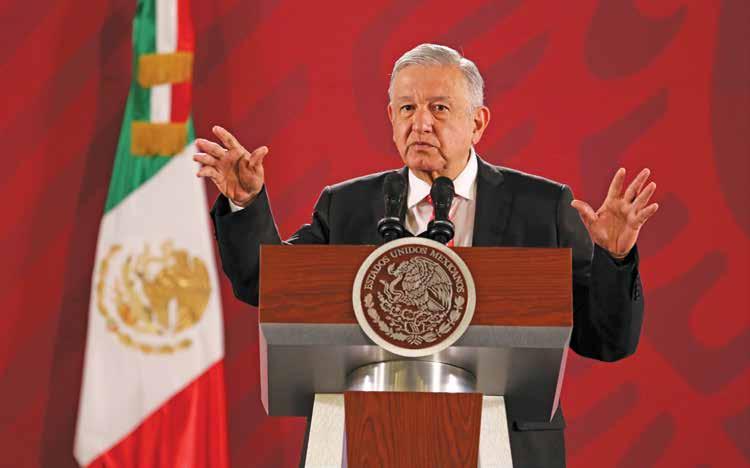
the stakes in support of these groups, tripling welfare spending from $8 billion to $24 billion in 2024, from Jóvenes Construyendo El Futuro (Youth Building the Future) to a basic universal pension. AMLO has further increased its commitment, pledging to spend 25% more on social programmes in 2024, or $30 billion, in an election year.
AMLO and his party's election triumph have benefited greatly from the highest levels of Mexico's government's support of these historically excluded groups. Even though Morena officially formed as a political party in 2014, AMLO's presidential win in 2018 saw the party take the top elected position in Mexico in just four years.
Five years later, Morena is in charge of 22 of Mexico's 32 state governments. It's difficult to envision Morena's explosive rise in success without AMLO's deft use of social media to encourage voting, particularly among these marginalised communities.
The pension reform was first mentioned by AMLO in 2020, but it wasn't fully announced until February 2024, along with 20 other reforms that varied in their extent and importance. The Chamber of Deputies Committee on Social Security's vote on the plan brought pension reform to the fore.
In short, the proposed reform aims to amend Article 123 of the Mexican Constitution to allow workers 65 and older who have paid into the current retirement pension system, which went into effect in 1997, to receive a pension that is equivalent to their most recent monthly salary, but not more than the average monthly salary of an IMSS worker, which is approximately 16,777 Mexican pesos ($978).
These pensions are only available to employees in the formal sector, which means that to qualify; an employee must be covered by social security in some capacity. The two options are the Mexican Institute of Social Security (IMSS) and the Institute of Security and Social Services
for State Employees (ISSSTE).
The changes implemented in 1997, during the administration of Ernesto Zedillo, and during Felipe Calderon's following time as president have resulted in a substantial transformation in Mexico's retirement savings system over the last thirty years. Before 1997, pensioners got a monthly pension equivalent to their average income for the five years before retiring, according to Luisa María Alcalde, Mexico's Secretary of the Interior.
Fundo de Pensiones del Bienestar (Welfare Pension Fund) is a new public fund that the AMLO administration has proposed to create to finance this new pension programme. The new pension fund's funding source is the subject of discussion. These monies will come from retirees aged 70 and above whose accounts have been untouched for a minimum of three years, that is, without any withdrawals or deposits.
Administradora de Fondos para el Retiro, or Afore, is currently in charge of these pension funds, which have a total value of almost $40 billion in Mexican pesos, or $2.3 billion. Of these accounts, 4.4% have remained unopened for longer than ten years, according to Alcalde. However, AMLO did point out that safeguards would be in place to ensure that employees or their dependents who later claim the assets stolen can still access them.
The government will also utilise the money it saves by collecting debts, selling off government real estate, and reducing spending to support the Fondo de Pensiones del Bienestar. Two-thirds of the members in both chambers of Congress must vote in favour of this measure.
According to the Mexican opposition, it is against Article 14 of the Constitution to transfer funds immediately into a new fideicomiso (trust) without first obtaining judicial clearance. With ten or so banks acting as the main fund administrators, AMLO, however, argues that the current pension system is a monopoly.
AMLO even went so far as to compare
Expenditure on pension benefits in Mexico
One matter that caused controversy in the media is that, in situations where the accounts have been dormant for a year, the WPF will additionally obtain monies maintained by the Afores that have not been claimed by the workers or their beneficiaries ten years after they were entitled to them
the proposed change to theft and claim that these financial corporations are so strong that they dominate the media in Mexico and are spearheading campaigns to oppose the reform's adoption. The president claims that the reason for these remarks is that the change will hurt the banks, not the pension beneficiaries.
By adding the so-called Solidary Supplement (complemento solidario) to the MGP, the government will guarantee this advantage. Employees contribute to individual retirement accounts run by Afores, together with payments from the government, companies, and other parties under Mexico's pension scheme. This sum of savings is what their monthly pension will come from when they retire. As soon as the worker's savings are insufficient, the government subsidises their pension so that they obtain the MGP if the balance is insufficient to attain the MGP. As a result of the 2024 reform, the pension will now match the final contributed pay thanks to the addition of the Solidary Supplement to the MGP.
Thus, the Solidary Supplement establishes a new fiscal obligation that will be specifically funded by the WPF, with an initial capital of 64 billion Mexican pesos (about $3.8 billion). The National Fund for Tourism Promotion's real estate income and the money from the National Agricultural Development Fund's liquidation are just two of the many sources from which the fund will draw.
One matter that caused controversy in the media is that, in situations where the accounts have been dormant for a year, the WPF will additionally obtain monies maintained by the Afores that have not been claimed by the workers or their beneficiaries ten years after they were entitled to them.
In such a case, the respective institutions would dispose of the accounts under the previous provisions of the new laws of IMSS, ISSSTE, and the Institute of the National Housing Fund for Workers provided that these institutions
established a reserve to return the funds to the workers or their beneficiaries if they later claimed them.
Under the new legislation, those unclaimed accounts will go to the WPF, which the Ministry of Finance will establish as a public trust fund at Mexico's Central Bank (Banco de México). It is nevertheless necessary to set aside funds to guarantee that employees or their beneficiaries can get reimbursements when they need them.
The new law also unequivocally states that workers' property rights over their assets are imprescriptible, and the reform only affects the institution in charge of managing those rights for those who fit the specified requirements (the resources that will be transferred to the WPF are expected to constitute less than 0.5% of the total assets under the Afores' management).
Stated differently, the WPF will now be in charge of managing unclaimed money that was previously under the control of social security organisations, and it will still be their responsibility to keep a reserve to cover any future claims. Since the pre-reform system had a reserve, it never failed to return any claimed cash; there is no reason to think that under WPF, this would not be the case.
According to projections, the number of people receiving the Solidary Support Aid will increase from 8,529 in 2024 to almost 2.7 million by 2050. On average, each senior will receive 4,592 Mexican pesos (about $275) every month in supplemental subsidies. To guarantee sustainability, the reform incorporates an actuarial evaluation of the financing sources every eight years, allowing for modifications if the anticipated amounts prove to be inadequate.
This latest change is a component of the federal government's ambitious pension policy, which demonstrates a clear commitment to providing superior
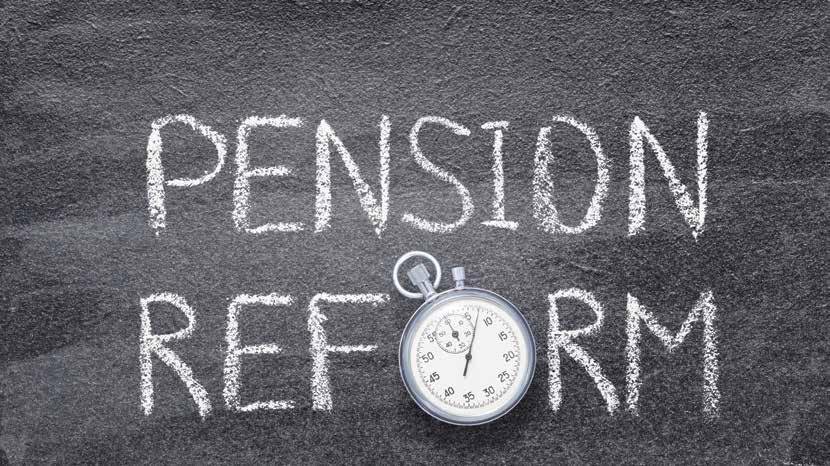
retirement benefits. The nation has developed a unique mixed model that complements the changes made in 2019 and 2020 with the most recent ones made in 2024. This model creates a more robust and inclusive environment because it includes a universal non-contributory pillar, which is crucial for a labour market that is characterised by high levels of informality, or low contribution density rates.
In addition, it has lowered the number of years of payments needed to be eligible for a pension, which benefits the initial worker generations under the Afore system who would not have been able to get benefits at all otherwise.
Furthermore, if a worker's pay is below average, the reform passed in May 2024 guarantees that the first generation of workers to acquire pension status under the individual-account, definedcontribution system will get pensions with a 100% replacement rate. This policy might be the missing motivation for more workers to pursue formalisation in a country like Mexico, where half of the population still works under informal systems.
The WPF offers a stable financial stream for the reform's finance for at least the ensuing ten years. Nonetheless,
the law's requirement for an actuarial evaluation and a final replenishment from new sources following eight years of operation is a smart one. It will then be possible to make any necessary adjustments at that point.
The new mixed pension model in Mexico marks a substantial breakthrough in the country's labour circumstances by combining the finest features of both contributory and non-contributory schemes. More importantly, though, it not only protects but enhances the Afore system. This is significant because, in addition to having the best and most worker-centred retirement fund management system, Afores plays a significant role in the Mexican economy, accounting for 20% of the nation's GDP in domestic savings at the moment. Previous estimates for this amount before the new model put it at 35% by 2040; however, the projection for that year is now as high as 56% of GDP. Undoubtedly, this is positive news for Mexico's economy, the banking system, and the workers themselves.
The new mixed pension model in Mexico marks a substantial breakthrough in the country's labour circumstances by combining the finest features of both contributory and non-contributory schemes. More importantly, though, it not only protects but enhances the Afore system
Analysis
GBO Correspondent
The primary focus of the central banks of at least twenty-three countries has shifted from inflation to other areas since 2000
A central bank calling the shots on monetary policies is a must for the 21st century economy. Furthermore, these banks regulate the movement of credit and money within a nation, with the potential to impact employment, inflation, economic growth, and financial stability. If handled strategically, these factors can give politicians a boost in the run-up to an election while simultaneously causing long-term economic implications.
Consequently, central banks have been granted considerable freedom to independently set interest rates without being influenced by political agendas. This has happened recently all over the world. The gold standard of managing national finances has been data-driven, technocratic monetary policymaking since the early 1990s, as opposed to politically driven decisions.
In nations like Sweden and Switzerland that have autonomous central banks, the rate of inflation has been comparatively low and steady. In contrast, nations like Argentina and Turkey, where central banks have to dance to their political bosses’ tunes, saw more periods of severe inflation.
However, politicians across the nations have put more pressure on central banks over the past ten years, even though independence is perceived to be effective. They want voters to be grateful for a booming economy and low-cost loans.
The ‘Trump’ example
Donald Trump is one example. During his presidency, Trump called for lower interest rates and attacked his selection to lead the United States Federal Reserve. Now, if Trump wins in 2024, some of his supporters have developed plans that

would see the Republican participating in Fed meetings to determine interest rates or, at the absolute least, succeed current Fed Chair Jerome Powell.
As per the latest Bloomberg Markets Live Pulse survey, 44% of respondents said they expect Trump to seek to politicise the central bank or limit its power if he returns to the White House. Overall, they put a probability of 40% on the Fed losing its autonomy under a second Trump administration.
The unlikely situation of the Fed's independence being cut down upon will likely rock financial markets, apart from undermining investors’ faith in the Fed as overseer of the world’s largest economy and exposing it to political pressure to cut interest rates. The Trump circle's "Fed Plans" seem an ill-timed one, given the fact that the central bank is already facing the pressure of cutting down its more than two-decade-high benchmark rate.
"More than one-third of the respondents said
that Trump would likely use social media and public appearances to jawbone the Fed, though 14% anticipate that he will try to demote Chair Jerome Powell before his term ends in 2026," Bloomberg stated.
A report from The Conversation stated that experts do not find it shocking when policymakers attempt to sway central banks. Even in the wake of independence, monetary policy has always been partisan. For starters, central banks are still a part of the government apparatus, and any independence that has been bestowed upon them can always be revoked by amending the law or reversing long-standing policies.
Furthermore, the incentive for politicians, particularly those before an election, to intervene in monetary policy stems from the fact that low interest rates provide a powerful and expedient way to stimulate economic growth. Despite the understanding that there are consequences to challenging an independent central
Source: Statista
bank, potential negative reactions from financial markets or the risk of inflation, the temporary control of a powerful policy instrument can be too enticing to resist.
In general, central banks are shielded by laws that grant their leadership lengthy terms, permit them to concentrate their policy efforts on inflation, and severely restrict lending to other branches of the government.
Naturally, no legislation can foresee every scenario that might arise in the future. This could lead to opportunities for illegal activity or political meddling. Additionally, central bankers occasionally face abrupt terminations. However, laws do serve to rein in politicians. For example, laws shielding central banks from political meddling have assisted in lowering inflation and limiting central bank lending to the government, even in authoritarian nations.
Political candidates are appointed to leadership positions in central banks. According to a 2023 study, the head of state appoints roughly 70% of central bank leaders, either on their own or in coordination with other executive branch officials. This guarantees that the central bank's preferences align more closely with those of the government, which can strengthen the bank's legitimacy in democracies but increase its susceptibility to political influence. Alternatively, the legislative branch or even the board of the central bank may be involved in appointments. Within the US, the Federal Reserve Board is appointed by the president, but the Senate has the authority to reject candidates who are unorthodox or incompetent.
Furthermore, many central bankers hold their positions long after the
individuals who nominated them were voted out of office, even in cases where appointments are political. By the end of 2023, five years will be the most common duration for governor appointments, with legal mandates lasting six years or more in 41 countries.
Globally, low inflation was the primary objective of all but six central banks as of 2023. However, a lot of central banks are mandated by law to undertake additional, sometimes contradictory objectives, like full employment, financial stability, or support for governmental policies.
Around 38 central banks fall into this category, either because they have more complicated objectives or the explicit dual mandate of employment and price stability. For instance, in Argentina, the central bank’s mandate is to provide 'employment and economic development with social equity.'
Central banks may become politicised as a result of competing interests. Both stable prices and maximum sustainable employment are two of the Federal Reserve's dual mandates in the US. Economists have contended that low inflation is a necessary condition for maintaining high employment rates, and these objectives are frequently complementary.
Nevertheless, the Fed's dual mandate has become a hotbed of political manoeuvring during periods of concurrently high unemployment and inflation, such as the late 1970s or the end of the COVID-19 pandemic in 2022. The primary focus of the central banks of at least twenty-three countries has shifted from inflation to other areas since 2000.
Limits on government lending
To aid governments waging wars with

funding, the first central banks were established. Today, however, the primary means of safeguarding price stability against unmanageable fiscal spending is to restrict lending to governments.
The results of failing to do so are littered throughout history. To help their governments meet their spending targets, Latin American central banks, for instance, printed money in the 1960s and 1970s. However, it did not ensure political stability or growth and instead led to severe inflation.
These days, lending restrictions are closely linked to lower inflation in developing nations. Furthermore, highly independent central banks have the power to impose their own loan conditions or reject requests for funding from governments.
However, nearly 40 nations have reduced the ability of their central banks to impose restrictions on central government funding over the last 20 years. In the more extreme cases, the central bank has been transformed into a possible source of funding for the government, as in Belarus, Ecuador, or even New Zealand.
Recently, governments have made calls for meetings with central bank leadership, criticised bank policy in statements, and pushed for lower interest rates as ways to exert influence over central banks. The same central bankers have also been held accountable by politicians for several alleged misdeeds, including failing to foresee economic shocks like the financial crisis of 2007–2009, going beyond their authority through quantitative easing, and causing extreme inequality or instability in the process of attempting to save the financial industry.
Furthermore, major central banks have had difficulty controlling inflation since the middle of 2021, which has prompted politicians who support nationalism and anti-democracy to question the benefits of an arms-length relationship. Yet historically, reducing the independence of central banks has always resulted in high inflation.
Globally, low inflation was the primary objective of all but six central banks as of 2023. However, a lot of central banks are mandated by law to undertake additional, sometimes contradictory objectives, like full employment, financial stability, or support for governmental policies

You're not alone

According to FDIC, over 25% of people with annual incomes under $15,000 do not have a bank account
GBO Correspondent
What percentage of people do not own a bank account? And how hard is it these days to survive without one? The importance of these questions is growing as more American establishments are declining to accept cash payments. Retailers and eateries that don't take cash turn away customers without bank accounts.
According to the most recent figures, a sizable portion of the population remains "unbanked"—about 6 million Americans, or roughly the population of Wisconsin. Furthermore, over a billion people do not own a bank account outside the United States.
Many stores feature signs that exclaim how inclusive and friendly they are, right next to them is another sign that says,
"No cash accepted." This implies that those without bank accounts are not welcome.
Why do Americans lack bank accounts?
The Federal Deposit Insurance Corporation (FDIC) asks people without bank accounts why they don't have one and polls households regarding their interactions with the banking system. Individuals can reply with more than one response. For more than 40% of respondents, the most common cause in 2021 was insufficient funds to cover the minimum balance.
This is in line with evidence that indicates a lower likelihood of bank account ownership among impoverished households. According to FDIC, over 25% of people with
annual incomes under $15,000 do not have a bank account. Nearly all respondents with annual incomes over $75,000 have some kind of bank account.
The second and third most often given responses indicate that some people have doubts about banks. A third of those who responded to the survey stated they "don't trust banks," and another third agreed that "avoiding a bank affords more privacy."
The expenditures associated with dealing with a bank completed the top five factors. A quarter or more of the respondents thought that bank account fees were excessively high, and a similar percentage thought that fees were too erratic.
Even though rich and middle-class people don't pay for bank accounts upfront, those who cannot keep a minimum amount may incur expensive fees.
According to a recent Bankrate poll, basic monthly service rates are within the $5–$15 range. Also, banks get $4 to $5 every time a customer uses an ATM to take out cash or needs a service like cashier's checks. Overdraft fees might amount to approximately $25 for each overdrawn account.
bank accounts as "the unbanked," while "the underbanked" are those who have bank accounts but primarily rely on other services such as check-cashing shops.
American households have 19 million underbanked and nearly 6 million unbanked, according to the most recent FDIC data. With an average household consisting of 2.5 individuals, this implies that more than 15 million people are living in houses without a bank link and 48 million more in homes with a shaky relationship.
Adding the two numbers together, The Conversation found that about one in five Americans had little to no ties to banks or other financial organisations. This may prevent people from accessing cash-free retailers, eateries, transit, and healthcare services.
The FDIC estimates of the unbanked population are probably not accurate. Additional questions about banking and not banking have been included in a survey that is distributed to respondents at home. This implies that it is missing undocumented immigrants, homeless persons, and temporary residents without a fixed address.
These individuals most likely lack access to banking, as opening a bank account requires providing a government-issued tax identification number and a verified address. There are millions more people in the cashonly economy than the FDIC forecasts, considering that about 2.5 million migrants entered the US from Mexico in 2023 alone.
Although the number of people with bank accounts is comparatively high in the United States, the situation is different in other countries. The World

Bank has produced a database that displays the proportion of the populace in each nation with access to financial services. In contrast to the FDIC, the World Bank defines "banked" as including everyone who sends and receives money via a smartphone as having a bank account.
World Bank estimates show over 25% of adults worldwide lack access to a bank or mobile phone account. However, that varies greatly by area. While only over half of people in the Middle East and North Africa have a bank account, practically everyone in nations that utilise the Euro has one.
In countries like Brazil and India, there has been great success in integrating a vast majority of people into the banking grid. Brazil's decentralised payment system called the Pix, which helps people pay using their phones, has been lauded internationally. Though 34% of Brazilians don't have a bank account, Pix has been a grand success.
In India, the Unified Payment
Interface has integrated the formal economy into the banking system. Granting millions access to some form of banking.
Many of us pay without giving it much thought—swiping our credit cards, tapping our phones, or inserting our debit cards. Nonetheless, the number of unbanked individuals is at least 6 million in the United States and about 1.5 billion globally.
The unbanked must resort to payment options like prepaid debit cards when establishments stop taking cash. These prepaid cards are pricey, though. One of the biggest American stores, Walmart, for instance, provides a reloadable basic debit card. The card costs $1 to purchase, and there are fees of $6 a month plus an additional $3 for each cash load at a Walmart cashier. It's a high price to pay at least $10 to set up a debit card for a few purchases.
The next time you see a "no cash
The number of people without a bank account is significant, with about 6 million unbanked Americans and over 1.5 billion globally. The reasons for not having a bank account vary from insufficient funds to concerns about privacy and high fees Feature \ Americans
accepted" sign in a storefront or restaurant window, you're essentially looking at a business that is shutting off a large number of underbanked and unbanked individuals. A straightforward solution to guarantee that everyone can participate financially in the modern economy is to mandate that all firms accept cash.
The number of people without a bank account is significant, with about 6 million unbanked Americans and over 1.5 billion globally. The reasons for not having a bank account vary from insufficient funds to concerns about privacy and high fees.
The unbanked and underbanked face challenges accessing cash-free services and may have to resort to expensive prepaid debit cards. To ensure inclusivity in the modern economy, it is essential to consider making it mandatory for all businesses to accept cash as a viable payment method.
The Central Bank of Oman (CBO) distributed Treasury bills to raise OMR 31.15 million. The designated treasury bills had a value of RO 15 million and a 28-day maturity period. The minimum accepted price was RO 99.650 per RO 100, while the average accepted price was RO 99.650 for every RO 100. The average yield was 4.57852%, and the average discount rate was 4.56250%.
On the other hand, the RO 16.15 million worth of designated Treasury bills had a 91-day maturity period. The minimum accepted price was RO 98.730 per RO 100, while the average accepted price was RO 98.732 for every RO 100. The average yield was 5.14929%,
Bangko Sentral ng Pilipinas

and the average discount rate was 5.08402%.
The Ministry of Finance issues Treasury bills, which are highly secured short-term financial instruments that allow licensed commercial banks to invest excess capital. These bills also promote the local money market by creating a benchmark yield curve for shortterm interest rates. Furthermore,
An analyst predicts that if the Bangko Sentral ng Pilipinas (BSP) decides to lower borrowing costs at its upcoming meeting in August, the peso will drop considerably versus the US Dollar.
An early rate cut is "out of the question," according to Shi Cheng Low, country risk analyst at BMI Country Risk and Industry Research, even in the face of lessening price pressure in the Philippines.
Currency stability is undoubtedly a drawback of (rate cuts). He stated that the BSP has been actively intervening during the period when the peso is very close to the 59 to $1 level, which
is the level that the BSP defended in 2022.
''But let's just say they cut (interest rates) in August, I'm pretty sure (the peso is) going to breach the 59 to $1 level mark and possibly reach 60 to $1,'' he said, adding that currency stability will be the biggest constraint in policy easing moving forward.
the treasury bills promote the local money market by creating a benchmark yield curve for shortterm interest rates.
It should be mentioned that the Treasury Bills Discounting Facility with CBO offers a discount rate of 6.50%, while the interest rate on the Repo operations with CBO is 6%: This whole para needs to be changed.

points, kicking off a muchawaited loosening cycle to support the economy.
However, proving Low's assessment wrong, the central bank has now decided to cut its key policy rate by 25 basis
However, in a good news, the currency rose 0.4% against dollar on August 22, hitting its highest since early April.

Japan's top currency envoy has announced that authorities would intervene in the foreign exchange market as needed after the Yen's overnight surge sparked speculation.
Masato Kanda, the Vice-Finance Minister for international affairs, said that recent moves in the value of the Yen were not consistent with fundamentals but he would not comment on whether or not authorities had interfered in the currency market to support the yen.
Chief Cabinet Secretary Yoshimasa Hayashi also indicated that the government was prepared to intervene in the market to stop the sharp decline in the yen’s value by saying that all available measures would be taken to manage exchange rates.
The comments on the Yen end the recent quiet from Japanese officials, who have remained silent about whether or not they are prepared to step in as some analysts doubt that jawboning will be sufficient to halt sharp declines in the value of the Yen.
"I've found recent big currency moves strange, from the perspective of whether they were in line with fundamentals, and it would be highly concerning if the excessive volatility, driven by speculation, pushes up import prices and negatively affects people's lives," Kanda said.
The Central Bank of Egypt (CBE) withdrew EGP 1.249 trillion from 30 banks in open market operations. This comes after 31 banks withdrew EGP 1.082 trillion recently.
The interest rate that is being offered during the weekly fixedrate auction has been modified by the CBE to 27.75%. New guidelines for deposit tying in open market operations have been introduced by the CBE.
The CBE announces the operation size and accepts bids based on each bank's percentage of the total bids, applying the main operation rate. These operations are conducted weekly through a fixed-rate tender.
To improve the impact of
monetary policy decisions and comply with global best practices for liquidity management, the CBE has switched from using the allocation method to accepting all bids (Full Allotment) for the primary operation of deposit tying.
On April 23, 2024, this modification went into effect, and the CBE website published the operation's results. By controlling liquidity and making sure that the weighted average overnight interest rate in the interbank market is in line with the main operation rate (corridor rate), the CBE is still dedicated to upholding consistency and balance.

Analysis
GBO Correspondent
On the dark web, several areas are made expressly to provide anonymity and can only be accessed with specialised software like Tor
The dark web—doesn't that sound dubious? It makes one think of a lawless underworld that only criminals and hackers dare enter. Though a little more ordinary, the reality is still quite hazardous.
Accessing the dark web necessitates specialist software, unlike the clear web, which is accessible to anybody with an internet connection. This is due to the dark web's inherent encryption, which makes it especially helpful for illegal activity. You won't hear about many of the dark web's advantageous applications, though.
Take a brief tour of the dark web to discover exactly what occurs there.
There is a hidden section of the internet known as the dark web. Google or Bing won't be able to help you find it. It's simpler if you consider it to be a different kind of the internet. Although there are differing definitions, most people concur that standard search engine indexing does not provide access to the dark web.
While some claim that the term "dark web" refers exclusively to content housed on the Tor network, others define it as any internet service that requires anonymising software to access. Either way, softwareenforced anonymity is a recurring motif in all definitions of the dark web.
Search engine-indexed websites and services that are available through common web browsers make up the clear web, sometimes referred to as the surface web. It encompasses everything from social networking and news websites to e-commerce and streaming services. Because many governments control and keep an eye on the transparent web, it can be challenging for those

offering illicit goods and services to do business there.
The deep web, which includes all internet content not indexed by search engines, comes next. There are scholarly materials, private databases, and other nonpublic data on the deep web. Essentially, to access anything on the deep web, you have to be aware of it beforehand.
One part of the deep web that is challenging to control is the black web. On the dark web, several areas are made expressly to provide anonymity and can only be accessed with specialised software like Tor.
Because of its emphasis on privacy, the dark web serves as a shelter for both legal and illegal activity. On the one hand, it gives journalists, activists, and whistleblowers a safe space to share material that is secret and communicate. However, because of its anonymity, it attracts criminal activity including cybercrime, illegal arms sales, and drug trafficking.
Every Tor node on the network is a user, making Tor a decentralised network. For Tor to function, your internet traffic must first pass through several user nodes located all over the world before arriving at an exit node. The name "Onion Router" comes from the fact that each relay, like peeling an onion, decrypts a layer of encryption to reveal the next destination.
It is quite difficult for someone to link your activity to you because this method effectively hides your IP address. There is another use for Tor routing, even though most users use it to route their traffic to the clear net.
Because onion routing provides anonymity, web servers can be hosted inside the Tor network, guaranteeing that no one accessing or hosting service inside the network can link a real IP address to any traffic passing through it. It is not feasible to monitor the traffic
being sent to services on the Tor network due to the use of peer-to-peer encapsulation and encryption.
Thus, you must download and install the Tor Browser to browse the black web. You will then need to know the website address that you want to visit. These websites are inaccessible through standard browsers, but you can use Google to look for links to them. Proceed with caution, as link directories may list unlawful websites.
A VPN is an additional layer of protection when used in conjunction with Tor, even if Tor offers some anonymity. You can access the Tor network without any disruption by utilising a VPN to get around restrictions placed on Tor traffic by certain internet service providers (ISPs).
The reputation that the dark web has for supporting illegal conduct is well-earned. Although there are a few websites that promote narcotics, stolen data, or firearms over the open internet, they are not very common. Except for extremely focused Interpol takedown efforts, criminals can operate virtually unhindered on the dark web due to the anonymity it provides, shielding them from government retaliation.
That being said, not every user of the dark
web is a criminal.
Especially in nations with repressive regimes, journalists and activists frequently utilise the dark web to safely interact with sources and get around censorship. Dissidents and whistleblowers can communicate material on the dark web safely and without fear of retaliation. Always-on encryption protects their identities while allowing them to organise, communicate, and report injustices.
Despite their frequent interchangeability, the words "deep web" and "black web" really refer to different subsets of the same information. The deep web includes everything on the internet that conventional search engines don't index. This means that you can access the deep web without the need for additional software; all you need to do is log in to the intranet of your place of employment or education.
Comprising most of the internet, the deep web is enormous. It's important to remember that the deep web is not always evil. The majority of its information is legitimate and useful for daily tasks including personal account management, accessing scholarly research, and internet banking.
Because of this, the dark web is only a small portion of the entire internet that you are unable to uncover while using a search engine. Although it's easy to mix the two up because they both refer to areas of the internet that aren't normally accessible, in actuality, they indicate very different things. It doesn't help that they both sound alike. Dark
Source: Statista


The dark web is a hub for illicit behaviour, even though not all of its users are criminals. You have to use extreme caution when utilising it. Your anonymity may not guarantee that you won't encounter other users on the dark web, particularly if you provide personal information such as your location, bank account information, or true name.
That being said, there is far more oversight of the dark web than you might think. Intelligence services frequently breach weapons and drug trafficking websites to employ honeypots. The agency in question tries to gather as much information as it can about the users of these marketplaces while they are still open, in anticipation of potential arrests. Interacting with these markets may put you at risk of scams and legal issues. Don't think about it; it isn't worth it.
Malicious software and unstoppable scams abound on the dark web as well. Malware is present everywhere because of the decentralised structure of the dark web, which makes it nearly impossible to contact a website host to report malware distribution. Installing malware that can steal your personal information, lock you out of your data, or track your actions can happen when you
download the incorrect file from the dark web.
To lessen the security concerns associated with browsing the dark web, use a VPN in conjunction with Tor. A notification will appear on your screen if you attempt to download a file that is known to contain a virus if you are using a VPN that has automated virus screening and traffic analysis. If you are unsure about the Tor network, using a VPN will help you remain anonymous and conceal from your ISP that you are using Tor.
This is especially helpful if you are browsing from a nation where Tor traffic might identify you as a possible source of political dissident content or leaks.


Feature \ Misinformation
CrowdTangle has been offering researchers and journalists crucial realtime transparency against conspiracy theories and hate speeches on platforms like Facebook and Instagram
Feature
GBO Correspondent
Mark Zuckerberg-led Meta may block news content from appearing on the social media platform in Australia, if the Australian government forces the tech giant to pay licensing fees.
As per Mia Garlick, Meta's regional policy director, the venture was awaiting Canberra's decision on whether to implement a newly introduced 2021 law, which grants the government authority to establish fees that American tech giants must pay media organisations for sharing links.
However, this copy is not about analysing the potential fallouts of the Australian government’s latest action against the social media giant. Yes, we are going to discuss something related to news and Facebook, but it will be all about the rampant spread of misinformation on the platform, as the world enters another crucial election year.
Not everything is black and white
It’s the election season in the United Kingdom. As per the media outlet ABC's report, there have been signs of foreign interference to influence the voters. ABC monitored five coordinated Facebook pages which have been spreading alleged Kremlin agendas, with some posting in support of Nigel Farage's populist Reform UK party, a key challenger to the Conservatives.
"The five pages identified by ABC Investigations as being part of a coordinated network appear to have little in common. One page presents itself as a pro-refugee leftwing group, while others reference white supremacist conspiracy theories and use AIgenerated images of asylum seekers to stoke anti-immigration fears. The ABC has been able to link these seemingly disparate pages by examining the location data attached to
News consumers who saw false or misleading information about key topics in selected countries worldwide as of 2023 (In Percentage)
Source: Statista
the pages' administrators, tracking paid ads, and by analysing the pages' similar or shared content," the report stated further.
The ABC shared its findings with disinformation experts, who said the network's activity had the hallmarks of a Russian influence operation. AI Forensics is the same European non-profit research organisation that published research in April 2024 about a covert influence operation called "Doppelganger," and found that Facebook ads with pro-Russian messages were targeting European Union (EU) voters. These ads, which reached more than 38 million users, were linked to EU-sanctioned Russian businessmen.
The network identified by ABC Investigations consists of five Facebook pages with a combined 190,000 followers. The pages have repeatedly shared the same images, text posts, and talking points and often post around the same time. The five pages featured criticism of several British parties including the Conservatives and Labour. Some of these pages have supported Reform UK leader Nigel Farage, with two calling him "the people's champion".
Let's shift to the United States, another election-bound nation (and perhaps the most crucial election).
"Someone in China created thousands of fake social media accounts designed to appear to be from Americans and used them to spread polarising political content in an apparent effort to divide the US ahead of next year’s elections," Meta reported back in 2023.
The network of nearly 4,800 fake
accounts was attempting to build an audience when it was identified and eliminated by the tech company. The accounts sported fake photos, names and locations as a way to appear like everyday American Facebook users weighing in on political issues. Misinformation/ disinformation will be aplenty.
"Instead of spreading fake content as other networks have done, the accounts were used to reshare posts from X, the platform formerly known as Twitter, that were created by politicians, news outlets and others. The interconnected accounts pulled content from both liberal and conservative sources, an indication that its goal was not to support one side or the other but to exaggerate partisan divisions and further inflame polarisation," reported the Associated Press.
CrowdTangle, a digital tool considered vital in tracking viral falsehoods, will be decommissioned by Facebook owner Meta, a move researchers fear will disrupt efforts to battle the misinformation flow on the social media space. CrowdTangle has been offering researchers and journalists crucial real-time transparency against conspiracy theories and hate speeches on Meta-owned platforms like Facebook and Instagram.
In the recently concluded EU elections and disinformation, Facebook became the potent weapon for the pro-Kremlin elements to push their narratives with ads purchased through fake accounts, as per a Politico report.
First exposed in 2022 and later sanctioned by the EU, the Russian campaign "Doppelganger" continued to influence Europeans online in the lead-up to the elections, despite being flagged by French and German authorities. As per AI Forensics, the misinformation operation is growing, reaching five to 10 times more people than previously thought.
The campaign took place as European authorities repeatedly tried to stamp out foreign and malign influence operations looking to sway public opinion. The

overall election integrity concerns were further fuelled by the rise of AI amplifying disinformation and fake content online.
Over 65% of ads connected to political and social issues were spreading unlabelled on Facebook in over 16 countries in the European Union and Meta reportedly took down less than 5% of these ads.
The dissemination of undeclared political ads violates Facebook’s policy and could even violate the EU’s new contentmoderation law, the Digital Services Act (DSA) that went into effect in August 2023 for very large online platforms.
Ben Walters, a spokesperson for Meta, said, "The Russian operations targeting Ukraine are aggressive and persistent, which is why we continuously detect and remove the accounts and Pages associated with these campaigns," while adding that threat detection teams had seen a "consistent decline" in the overall following of the coordinated campaigns from Russia in the past few years.
“If we do not oppose Ukraine’s accession to the European Union, we will ruin our
farmers,” said a paid post in French on January 28, as protests swept across EU countries from France to Poland to Germany.
The ad in French, portraying the import of Ukrainian chickens and eggs as “unfair competition,” is one of the nearly 4,000 sponsored messages pushed by thousands of fake Facebook pages operated by Doppelganger between August 2023 and March 31, 2024. Such messages were seen by at least 38 million users.
Around 138,600 Facebook users in France and 37,500 users in Germany saw at least one of these ads undermining Ukraine and the EU and connected to events like announcements of new aid packages to Kyiv, the Israel-Gaza conflict and farmers’ protests every day in that period. Researchers were still detecting new ads reaching hundreds of thousands as of April 15.
Fewer than 20% of the paid and boosted pro-Russian propaganda ads were taken down by Meta after being shown to users at least 2.6 million times. The AI Forensics researchers also identified more than 8,000 ads for crypto scams that reached over 128
CrowdTangle, a digital tool considered vital in tracking viral falsehoods, will be decommissioned by Facebook owner Meta, a move researchers fear will disrupt efforts to battle the misinformation flow on the social media space
million accounts mainly in France, Italy and Spain in January and February 2024, which seemingly came from a coordinated network.
"Doppelganger" was first uncovered in 2022 after spreading propaganda from websites spoofing Western media outlets like The Guardian, Ansa and Spiegel on social media networks like Facebook and X (formerly Twitter) through ads and fake profiles. Meta at the time estimated that the network had paid more than $100,000 for the propaganda ads.
The network allegedly focused on influencing Germany and France was also later found to impersonate government ministries and other media outlets like Le Monde. Meta identified two Russian companies behind the act, Struktura and Social Media Agency, in 2022. The EU sanctioned the entities in July 2023.
"AI Forensics used data from Facebook's public ad library to build and train its own algorithm on 230 million Meta ads to detect political ads across 16 EU countries. Meta

in August 2023 was forced, along with other major platforms to publish detailed information about all its ads in the EU in a detailed public library under the DSA. Meta started a repository in 2019 with selfdeclared political ads in the EU in 2019," Politico stated.
"The algorithm aimed to mimic Facebook’s moderation systems to identify political ads and looked for messages based on indicators like the names of leaders like French President Emmanuel Macron and German Chancellor Olaf Scholz, similar text or words connected to Ukraine targeted at people in 10 different languages," it noted.
Meta spokesperson Walters rejected the findings, arguing the social media company's ad library doesn’t include the 430,000 ads the company rejected in the EU between July and December 2023 before they were published. He also disagreed with the definition of political ad for the algorithm used for the report.
In September 2021, The Washington Post reported about a study of user behaviour on Facebook, which centred around the 2020 Presidential Elections, while taking into consideration long-standing arguments against the social media company’s algorithms fuelling the spread of misinformation over more trustworthy sources.
The study by researchers at New York University and the Universite Grenoble Alpes in France has found that from August 2020 to January 2021, news publishers known for putting out misinformation got six times the number of likes, shares, and interactions on the platform as did trustworthy news sources.
"The study helps add to the growing body of evidence that, despite a variety of mitigation efforts, misinformation has found a comfortable home — and an engaged audience — on Facebook,” said Rebekah Tromble, director of the Institute
for Data, Democracy and Politics at George Washington University, who reviewed the study’s findings.
Combatting the finding, Facebook said that the report measured the number of people who engage with content, but that was not a measure of the number of people who view it.
“This report looks mostly at how people engage with content, which should not be confused with how many people actually see it on Facebook. When you look at the content that gets the most reach across Facebook, it is not at all like what this study suggests,” the venture stated, adding that it had 80 fact-checking partners covering over 60 languages that work to label and reduce the distribution of misinformation.
The study’s authors relied on categorisations from two organisations that study misinformation, NewsGuard and Media Bias/Fact Check. Both groups have categorised thousands of Facebook publishers by their political leanings, ranging from far left to far right, and by their propensity to share trustworthy or untrustworthy news.
The team then took 2,551 of these pages and compared the interactions on posts on pages by publishers known for misinformation, such as the left-leaning Occupy Democrats and the right-leaning Dan Bongino and Breitbart, to interactions on posts from factual publishers.
"The researchers also found that the statistically significant misinformation boost is politically neutral — misinformationtrafficking pages on both the far left and the far right generated much more engagement from Facebook users than factual pages of any political slant. But publishers on the right have a much higher propensity to share misleading information than publishers in other political categories, the study found. The latter finding echoes the conclusions of other researchers, as well as Facebook’s own internal findings ahead of the 2018 midterm elections," Washington Post reported in 2021.
Sorry state of affairs
Facebook is increasingly restricting access to outside groups that make attempts to mine the social media company’s data. Post 2020, the White House had to repeatedly ask Facebook for information about the extent of COVID-19 misinformation on the platform, only to get no answers to their communications.
One of the researchers Facebook has clamped down on was NYU researcher, Laura Edelson. The company cut off Edelson and her colleagues’ accounts in 2021, arguing that her data collection, which relied on users voluntarily downloading a software widget that allows researchers to track the ads that they see, put Facebook potentially in violation of a 2019 United States Federal Trade Commission privacy settlement.
The commission shot back by stating that the settlement makes exceptions for researchers and that Facebook should not use it as an excuse to deny the public the ability to understand people’s behaviour on social networks.
Facebook also published a transparency report that showed the most popular content on the platform every quarter. However, the report was highly curated, and Facebook censored an earlier version of the report out of concerns about getting bad press, as per the sources cited by The Washington Post. Edelson's study showed that Facebook algorithms were not rewarding partisanship or bias, or favouring sites on one side of the political spectrum. Instead, the portal was amplifying misinformation because "it does well with users," and the sites that happen to have more misinformation are on the right. Among publishers categorised as on the far right, those that share misinformation get a majority, or 68%, of all engagement from users.
Feature \ Misinformation
The researchers also found that the statistically significant misinformation boost is politically neutral — misinformationtrafficking pages on both the far left and the far right generated much more engagement from Facebook users than factual pages of any political slant
GBO Correspondent
Ride-hail driver groups protested, lobbied lawmakers, and even engaged in negotiations with Uber during the twoyear spat over the arrangement
When the Minneapolis City Council in May 2024 reached an agreement with American cab aggregating giants Uber and Lyft to boost driver compensation and enhance working conditions, the immediate question emerged out of this particular development, who won?
As per the understanding, Uber and Lyft would concur on a wage floor that, after costs, would be inflation-pegged and equal to the $15 hourly minimum wage in the American state. There has been a heated battle between Uber, Lyft, their drivers, and lawmakers over the past two years. While some lawmakers have celebrated this as a 20% increase for drivers, the deal's pay rates are lower than practically every proposal.
Now, drivers who have been "deactivated" (i.e., sacked randomly by opaque algorithms) can challenge their dismissals. Funding is also available for the driver rights education programme at a "non-profit driver centre."
The true gem may be the demand for ride-hailing drivers to carry up to $1 million in insurance coverage, which now covers the period right after a trip ends. This will assist drivers in covering medical expenses and lost income in the event of assaults or mishaps.
However, this agreement maintains essential components of the digital ride-hailing business model, enabling Uber and Lyft to carry on with business as usual and subsequently weakening the compromise.
Ride-hail driver groups protested, lobbied lawmakers, and even engaged in negotiations with Uber during the two-year spat over the arrangement. Uber and Lyft threatened to go out of business three times in response to proposed laws, threatening to go on capital strikes.
The companies have caused political bloodshed each time: the
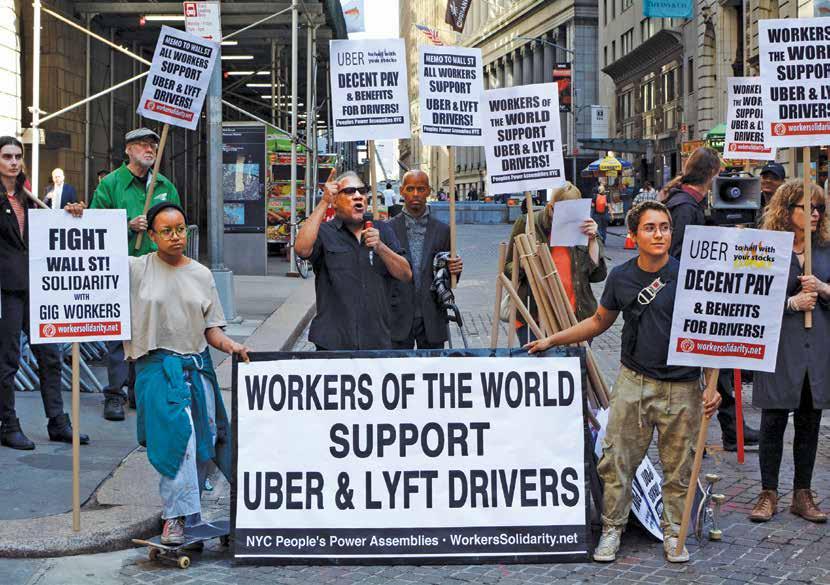
first threat forced Governor Tim Walz to veto a bill in May 2023; the second caused Minneapolis Mayor Jacob Frey to veto an ordinance that the city council had passed in August of the same year; and the third occurred after Frey again vetoed an ordinance in March, which was overridden by the city council.
These companies can strengthen their positions while limiting our political horizons by threatening capital strikes. Distracted from their immense structural power, we discuss driver pay rates they ultimately undercut. Cities apologetically soften their goals, consumers justify price increases, and motorists settle for incremental advancements.
According to a sympathetic account, drivers won right away. If Uber and Lyft departed the state, the drivers' earnings would be nothing. Drivers are better positioned to advocate for better terms if a deal allows them to keep working and receive higher salaries.
The true gem may be the demand for ridehailing drivers to carry up to $1 million in insurance coverage, which now covers the period right after a trip ends. This will assist drivers in covering medical expenses and lost income in the event of assaults or mishaps
The digital ride-hailing model is based on two fundamental pillars that consistently worsen working conditions for drivers: firstly, misclassifying drivers as contractors to reduce labour expenses; and secondly, communication asymmetry between firms, workers, and authorities. Minneapolis's agreement leaves both alone, but the choice to forgo data openness guarantees that working conditions would worsen as a result of what UC Irvine law professor Veena Dubal refers to as "algorithmic pay discrimination."
Companies such as Uber and Lyft use ongoing worker observation to determine the minimum wage required to maximise the value that each driver contributes.
According to Dubal, "totally random and opaque means" determine the value of a driver's labour even in cases where the tasks are identical.
Any idea of justice vanishes when predictability is eliminated, as employees are duped by algorithms into speculating about whether the costs associated with the tasks they are assigned will justify them, normalising unfavourable working conditions and longer hours. It takes more than just a pay floor to combat this trend.
Removing data openness leaves a significant gap in the bill. According to reports, Uber and Lyft pushed to prevent any assurance of a minimum income for each ride. Rather, over a two-week pay period, ride-hailing companies will top off drivers whose average earnings fall short of the requirement.
Furthermore, although the bill codifies pay transparency for drivers, it did away with the ordinance's mandate that ridehailing companies provide Minneapolis with regular, unrestricted data disclosures.
Uber and Lyft retaliated to New York City's wage floor, which is an hourly net income of $17.22, by instituting a tiered quota system and enforcing a lockout, a coercive tactic in which an employer refuses to provide workers work unless they agree to new terms. The more trips completed each day, the greater the likelihood that a driver would be able to plan shifts during busy business hours.
This meant that drivers had to work much longer hours to guarantee priority when it came to scheduling shifts. Simply put, drivers who didn't meet quota requirements couldn't use the apps. The companies saw tremendous success with the initiative. A deliberate deterioration of labour conditions during its first phase, which ran from June 2019 to March 2020,
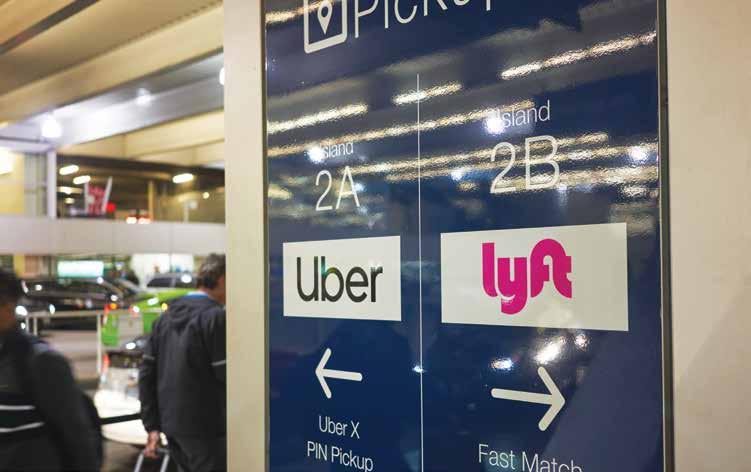
pulled 8,000 drivers off each station.
Even in the absence of a wage floor, drivers lived in cars and put the maximum strain on their bodies to survive under the false impression that they had no protection at all. Mainly, the on-demand labour model focuses on maintaining unequal power relations among these companies, drivers, passengers, and cities. Any agreement that skirts the issues of data extraction, algorithmic management, and driver misclassification is, at most, provisional. Uber and Lyft are skilled at distilling discussions and ideas into surface-level fixes. The urge to follow suit is natural given that drivers in large US cities routinely get starvation pay, according to recent UC Berkeley Labour Centre research. These drivers urgently need relief.
However, the success Uber and Lyft have had in evading billions of dollars in corporate taxes, changing labour laws, and taking over organisations supposed to control them, suggests that they will always find a way around regulations. We've been led to believe that there isn't a choice and that suggested policies, such as increased public transportation and ride-hailing services run by local governments or the state, won't be successful.
What's flawed is the digital ridehailing paradigm. It is costly, ineffective, discriminatory, and exploitative. Without a deregulated market, huge investor subsidies, and a powerful political apparatus to defend it, it cannot function. Ride-hailing services have adversely affected the quality of urban transit, caused significant increases in traffic and pollution, and negatively impacted working conditions in other businesses in nearly every place where they have been left to fester. For what purpose? The empowering of saboteurs who launder every expense imaginable onto the public while pocketing billions.
There will undoubtedly be another capital strike elsewhere. By misclassifying and abusing drivers until they fight back,
ride-hailing robs them of their dignity. Will there be another "compromise" the next time that doesn't affect the fundamentals of this strategy? Or are we going to finally walk away from the Faustian deal and take a chance on something different at the cost of the parasitic companies that are enslaving numerous cities, drivers, and passengers?
The recent agreement between the Minneapolis City Council and Uber and Lyft represents a complex victory with mixed outcomes. On one hand, drivers secured a wage floor, the ability to challenge deactivation, and better insurance coverage, marking a significant improvement in their working conditions.
However, the deal falls short of addressing the deeper issues within the ride-hailing industry, such as driver misclassification and the opacity of algorithmic management, which perpetuate exploitation and inequality.
Uber and Lyft have managed to maintain their business model, continuing practices that undermine drivers' stability and rights. Their repeated threats of capital strikes highlight the immense structural power they wield, forcing political concessions and weakening regulatory efforts.
This dynamic underscores a troubling reality: while incremental gains have been made, the fundamental problems of the digital ride-hailing model—its dependence on deregulation, investor subsidies, and exploitation—remain unchallenged.
Ultimately, the true victor of this agreement remains ambiguous. Drivers gain immediate, albeit limited, benefits, but the systemic issues that degrade their working conditions persist. This scenario calls for a reevaluation of our reliance on such exploitative business models and consideration of alternative solutions, such as expanded public transportation and municipally-run ride-hailing services. Only by addressing the root causes of exploitation can we hope to achieve a truly fair and sustainable ride-hailing industry.


Using generative AI in the workplace poses a major challenge of potentially exposing sensitive data unintentionally
GBO Correspondent
Generative AI tools like OpenAI's ChatGPT and Microsoft's Copilot are advancing quickly, sparking concerns about potential privacy and security issues, especially in the workplace.
A very good example here is Microsoft's new Recall tool which has raised alarms among privacy advocates for its capability to take screenshots periodically, leading the United Kingdom's Information Commissioner's Office to request more information on its safety in the upcoming launch of Copilot+ PCs.
Similarly, worries have arisen about OpenAI's ChatGPT and its upcoming macOS app, which experts fear could capture sensitive data through screenshotting. The United States House of Representatives has prohibited the use of Microsoft's Copilot by its staff, citing risks identified by the Office of Cybersecurity related to data leakage to unauthorised cloud services.
Gartner has also warned about the potential risks associated with using Copilot for Microsoft 365, highlighting the dangers of internal and external exposure to sensitive information. Additionally, after screenshots of odd and deceptive search results went viral recently, Google was forced to make changes to its brand-new AI Overviews feature.
Overexposed
Using generative AI in the workplace poses a major challenge of potentially exposing sensitive data unintentionally. According to Camden Woollven, who is
When creating prompts, it is recommended to be generic to avoid revealing too much information. Avvocato suggests using AI as a first draft and then adding sensitive information later
the group head of AI at GRC International Group, most generative AI systems act like "big sponges" by absorbing vast amounts of information from the internet to enhance their language models.
Steve Elcock, the CEO and founder at Elementsuite, points out that AI companies are eager to gather data to train their models, making it enticing behaviourally.
Jeff Watkins, the chief product and technology officer at xDesign, warns that this extensive data collection opens the door for sensitive information to be shared with outside parties or extracted through clever manipulation.
Moreover, there is a growing concern about the security of AI systems themselves, with the potential for hackers to target and exploit them. Woollven explains that if an attacker gains access to a company's AI tools powered by a large language model (LLM), they could steal sensitive data, manipulate outputs, or use the AI to distribute malware.
According to Phil Robinson, principal consultant at security consultancy Prism Infosec, there are growing concerns about the potential risks associated with "proprietary" AI tools like Microsoft Copilot,
which are generally considered safe for work. These tools could potentially be used to access sensitive data if security measures are not properly implemented.
Additionally, there is worry that AI tools could be utilised to invade the privacy of staff by monitoring their activities. While Microsoft claims that its Recall feature keeps snapshots on the user's PC and ensures privacy, there is scepticism that this technology could eventually be used for the surveillance of employees.
Generative AI presents potential risks, but businesses and individuals can improve privacy and security by taking certain precautions.
Lisa Avvocato, Vice President of marketing and community at data firm Sama, advises against putting confidential information into publicly available tools like ChatGPT or Google's Gemini.
When creating prompts, it is recommended to be generic to avoid revealing too much information. Avvocato suggests using AI as a first draft and then adding sensitive information later.

Additionally, when using AI for research, it is important to validate the information provided by asking for references and links to sources. It is also crucial to review AIgenerated code rather than assuming it is error-free.
Microsoft has emphasised the importance of configuring Copilot correctly and implementing the "least privilege" concept, which ensures that users only have access to necessary information.
According to Prism Infosec's Robinson, this is a critical consideration as organisations need to properly set up these systems and not solely rely on technology to guarantee security. Additionally, it should be mentioned that ChatGPT utilises shared data for model training, unless you disable this feature in the settings or opt for the enterprise version.
The companies that incorporate generative AI into their products assert that every effort is being made to safeguard security and privacy. Microsoft is eager to discuss the privacy and security features of its Recall product, as well as how users can manage the feature under Settings > Privacy and Security > Recall & Snapshots.
Google clarifies that information is not used for advertising and states that generative AI in Workspace "does not change our foundational privacy protections for giving users choice and control over their data."
While enterprise versions of its products are available with additional controls, OpenAI reiterates how it maintains security and privacy in its products.
OpenAI provides control over how data is used by offering self-service tools to access, export, and delete personal information, as well as the option to opt out of using content to enhance its models. The ChatGPT Team, ChatGPT Enterprise, and its API are not trained on data or conversations, and its models do not learn from user interactions by default, as per the
company's policy.
As AI technology becomes more advanced and prevalent in the workplace, the associated risks are likely to increase, warns Woollven. The emergence of multimodal AI like GPT-4o, capable of analysing and generating images, audio, and video, means that companies now must safeguard more than just text-based data.
Given this reality, individuals and businesses should treat AI like any other external service provider, advises Woollven. It is important to refrain from sharing sensitive information that you would not want to be made public.
Meanwhile, OpenAI has eliminated language from its usage guidelines that specifically forbade the use of its potent language technologies, like ChatGPT, for military objectives. The firm's prior policies explicitly prohibited the use of its AI tools and services for "weapons development" as well as "military and warfare," as the Intercept reported.
The explicit ban was subtly lifted in a revised usage policy. Experts say this would eliminate any direct applications by military forces or defence departments. Although there is still a general ban on harmful activities, military applications are no longer specifically excluded from usage under the new policy.
When questioned about the modification, an OpenAI representative said that the intention was to reduce the policy to "universal principles" such as "Don't harm others," but it is still unclear what this would mean in terms of possible military application.
“We aimed to create a set of universal principles that are both easy to remember and apply, especially as our tools are now globally used by everyday users who can now also build GPTs. A principle like ‘Don’t harm others’ is broad yet easily grasped and relevant in numerous contexts. Additionally, we specifically cited weapons and injury to others as clear examples,” OpenAI’s Niko Felix said.
Artificial Intelligence market revenues worldwide from 2020 to 2023 (In Billion US Dollars) 2020 296.7 2021 341.8 2022 432.8 2023 500.2
Source: Statista
After Morgan Stanley increased its price target on Apple's stock and labelled it a "top pick," citing the company's AI initiatives as a boost to device sales, Apple's stock saw a 2.5% increase to a record high.
With the recent release of Apple Intelligence, the iPad maker attempted to overtake Alphabet's Google and Microsoft-backed OpenAI by enticing users to upgrade their devices to utilise the new technology.
With a nearly 20% increase in share price this year, Apple now has the highest market value in the world at $3.62 trillion, thanks to its recent rise to $236.30.
"Apple Intelligence is a clear catalyst to boost iPhone and iPad shipments," Morgan Stanley analysts said.
According to analysts, Apple has 1.3 billion smartphones in use today, and the new technology is compatible with just 8% of iPhone

years.
American multinational investment giant Morgan Stanley increased its price target on Apple's shares to $273 from $216, up from its previous estimate of 230 million to 235 million iPhones sold annually over the next two years. The stock has performed better in 2024 so far than the S&P 500 index.
ChatGPT maker OpenAI is developing a novel approach to its artificial intelligence models in a project code-named "Strawberry."
The project, the details of which have not yet been made public, is being undertaken as the Microsoftbacked start-up works hard to demonstrate that the models it
provides can provide advanced reasoning capabilities.
A copy of a recent internal OpenAI document states that teams within the company are working on Strawberry. The document, which describes a plan for how OpenAI plans to use Strawberry to conduct research, was not available for

Apple now has the highest market value in the world at $3.62 trillion, thanks to its recent rise to $236.30
Reuters to verify the exact date.
According to Zawya, even at OpenAI, Strawberry's operational mechanism is closely guarded. The project described in the document uses Strawberry models to help the company's artificial intelligence (AI) do what OpenAI refers to as "deep research."
This involves the AI being able to plan and navigate the internet independently and reliably in addition to generating answers to queries. Interviews with over a dozen AI researchers indicate that this is something that has escaped AI models to date.
“We want our AI models to see and understand the world more like we do," an OpenAI spokesperson said.

According to Chief Technology Officer Greg Lavender, Intel's software push is progressing well, and by the end of 2027, the company may generate $1 billion in software revenue overall.
In 2021, when CEO Pat Gelsinger brought Lavender in from cloud computing company VMware to lead the chipmaker's software strategy, Intel generated software revenue of over $100 million. Three software companies have been acquired by Intel since then.
"I have a goal of getting to $1 billion of software and developer cloud subscription revenue. I think I'm on track to hit this goal by the end of 2027... maybe sooner," Lavender said.
Cloud computing and AI are just two of the software services and tools that Intel, which will bring in $54 billion in revenue in 2023, makes available for hire.
According to Lavender, the company has been investing in all three areas and his strategy is to concentrate on offering services in AI, performance, and security.
In a related development, Lavender stated that Intel is experiencing "a lot of demand" for its upcoming Gaudi 3 chip, which he thinks will enable the business to overtake competitors in the AI chip market.
Google Cloud
Recently, the Minister of Commerce and Industry and Minister of State for Communication Affairs, His Excellency Mr. Omar Saud Al-Omar, was present at an event to mark the opening of Google Cloud's new offices in Kuwait, which are licensed by the Kuwait Direct Investment Promotion Authority (KDIPA).
Google Cloud's dedication to assisting Kuwait in its journey toward digital transformation, which includes modernising government services and promoting economic development, is further demonstrated by this expansion.
As a centre for innovation and cooperation, the Google Cloud offices in Kuwait will bring together specialists from all over the company to collaborate closely with clients and partners.
“Under the visionary leadership of His Highness the Amir, His Highness the Crown Prince, and the guidance of His Highness the
Prime Minister, Kuwait has made great strides towards realising its National Vision 2035. This progress includes driving digital transformation, accelerating our smart economy, and developing crucial infrastructure," Saud Al-Omar said.
“The significance of cloud computing, artificial intelligence, and digital technologies in general, cannot be overstated. They are fundamental to economic growth and national development. By leveraging these technologies in government services, we can significantly improve the quality of life for our citizens," Al-Omar added.
As a centre for innovation and cooperation, the Google Cloud offices in Kuwait will bring together specialists from all over the company to collaborate closely with clients and partners

German chipmaker Infineon reduced the range of its revenue outlook for the entire year, following its Q3 revenue miss that was expected due to a slowdown in the recovery of its target markets.
The company's third-quarter revenue of 3.702 billion euros ($4.04 billion) was up 2% from the previous quarter despite missing the 3.8 billion euros predicted in a consensus provided by the company. This was primarily due to growth in the automotive and power and sensor systems segments.
Infineon Chief Executive Jochen Hanebeck said, "The recovery in our target markets is progressing only slowly. Prolonged weak economic momentum has resulted in inventory levels in many areas overlaying end demand."
The segment result exceeded expectations, growing by 4% to 734 million euros with a margin of 19%.
"In a market environment that remains

challenging, Infineon continues to hold up well," Hanebeck said, adding that the company is further strengthening its competitiveness through its cost savings programme announced earlier in 2024. Infineon now expects revenue of around 15.0 billion euros, versus prior guidance for 15.1 billion euros ($16.3 billion), plus or minus 400 million euros. Pre-market trading saw a 1.9% decline in Infineon shares at brokerage Lang and Schwarz.
Infineon's Q3 revenue was 3.702 billion euros, up 2% from the previous quarter but short of the 3.8 billion forecast
Elon Musk, the founder of Neuralink, claims that the company has successfully implanted its technology, which allows paralysed patients to operate digital devices simply by thinking, in a second patient.
Neuralink is currently conducting testing on its device, which is meant
to assist individuals who have suffered spinal cord injuries. With the help of the device, the first patient is now able to move the cursor on his laptop, play video games, browse the internet, and post on social media.
Musk provided little information about the second participant in his

remarks during a lengthy podcast that was made available recently. He only mentioned that the person had a spinal cord injury similar to the first patient, who was rendered paralysed in a diving accident.
According to Musk, on the brain of the second patient, 400 of the implant's electrodes are operational. On their website, Neuralink claims that 1,024 electrodes are used in their implant.
"I don't want to jinx it but it seems to have gone extremely well with the second implant. There's a lot of signal, a lot of electrodes. It's working very well," Musk remarked, while not disclosing when Neuralink performed the second patient's surgery.
Now, scientists will be waiting to see whether the company can avoid the mechanical difficulties that plagued the implantation of its first device.


